Multifunctional Cementitious Composites from Fabrication to Their Application in Pavement: A Comprehensive Review
Abstract
1. Introduction
2. Methodology
3. Properties of Multifunctional Cementitious Composites
3.1. Conductive Fillers
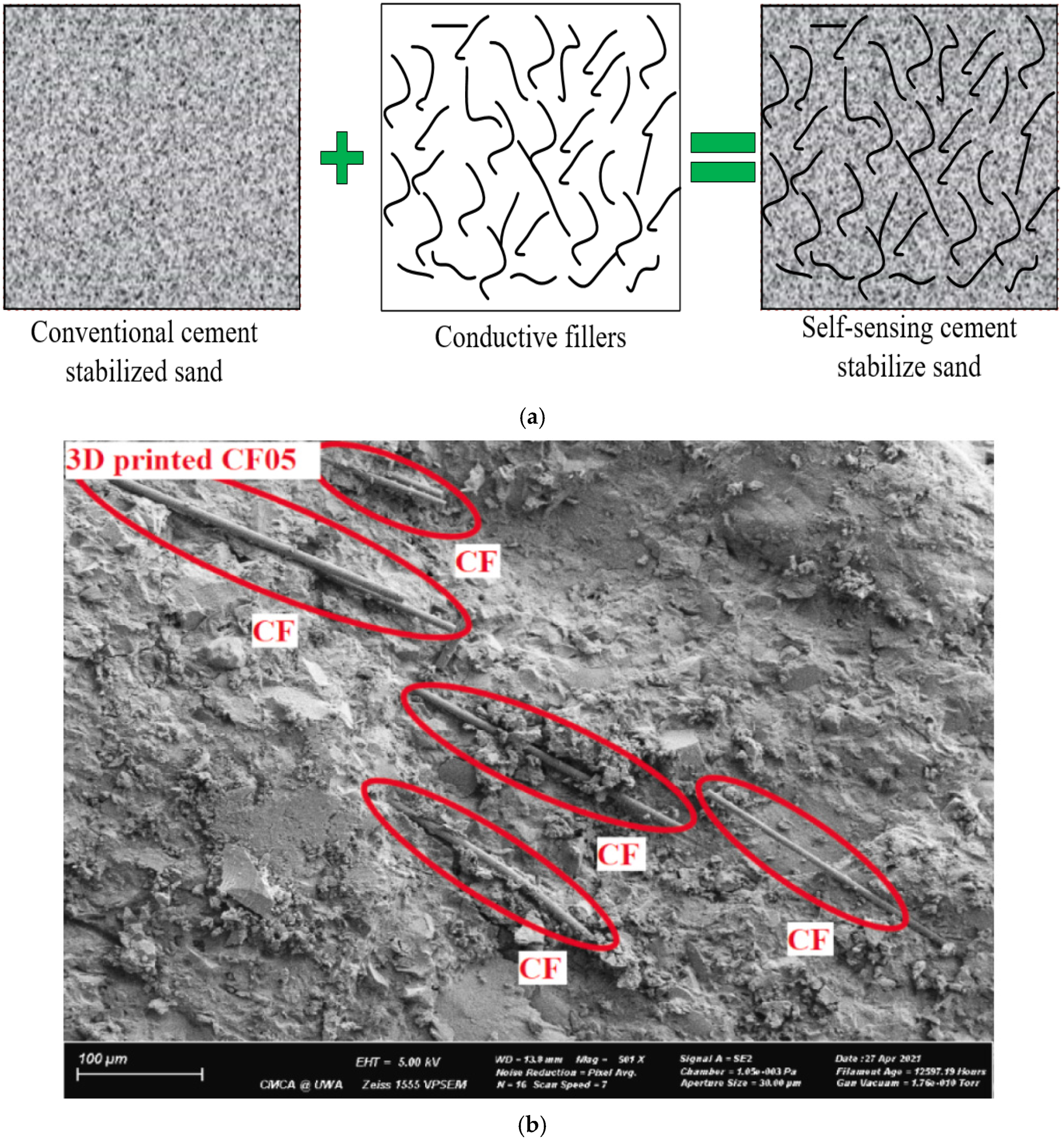
3.1.1. Carbon Fibers (CFs)
3.1.2. Carbon Nanotubes (CNTs)
3.1.3. Graphene
3.1.4. Carbon Black (CB)
3.2. Matrix Materials
3.2.1. Skeleton Materials
3.2.2. Binders
3.2.3. Additives
3.3. Electrodes Configurations
3.4. Contact and Non-Contact Electrical Measurement System
3.5. Surface and Bulk Electrical Resistivity
3.6. Electrical Conductivity
3.7. Percolation Threshold
3.8. Piezoresistivite Performance
3.9. Integrated Self-Sensing and Self-Healing
4. Challenges and Solutions
4.1. Agglomeration of Conductive Fillers
4.2. Polarization
4.3. Temperature and Moisture Effects
4.4. Environmental and Cost Considerations
4.4.1. Cement
4.4.2. Aggregates
4.4.3. Conductive Fillers
5. Application of Self-Sensing Materials for Transportation Infrastructures
5.1. Traffic Monitoring
5.2. Structural Health Monitoring (SHM)
5.3. Deicing and Snow Melting
5.4. Electromagnetic Interference Shielding
5.5. Cathodic Protection System
5.6. Grounding System
5.7. Energy Harvesting
6. Concluding Remarks
- ✓
- Various conductive fillers can be utilized in the fabrication of multifunctional cementitious composites. Their performance depends on multiple factors, including the type, content, combination, and characteristics of conductive fillers (e.g., length, thickness, and aspect ratio). Therefore, selecting an appropriate conductive filler is paramount to optimizing the self-sensing properties of cementitious composites. Additionally, the cost of conductive fillers varies depending on their type. While some may be more affordable, they may not significantly enhance multifunctional properties, whereas others, though expensive, may considerably improve performance. Thus, achieving a balance between cost and effectiveness is essential. Hybrid conductive fillers are often preferred to optimize both performance and cost-efficiency.
- ✓
- The percolation threshold of conductive fillers is a critical factor in the fabrication of multifunctional cementitious composites. Conductive fillers must be incorporated in sufficient quantities to substantially enhance electrical and thermal conductivity; however, beyond a certain threshold, further addition does not yield a significant increase in conductivity.
- ✓
- The configuration and material composition of electrodes also influence the performance of multifunctional cementitious composites. In this regard, both contact and non-contact electrode systems can be employed, with each having specific advantages depending on the application.
- ✓
- Several challenges hinder the practical application of multifunctional cementitious composites. These include the agglomeration of conductive fillers, the polarization of electrical signals, and cost and environmental concerns. To address these challenges, proper dispersion techniques must be employed to prevent agglomeration, optimized electrode configurations and measurement systems and sufficient conductive fillers should be used to minimize signal polarization, and sustainable materials, such as waste-based materials, should be considered to reduce costs and mitigate environmental impact.
- ✓
- Multifunctional cementitious composite pavements have potential applications in various domains, including traffic monitoring, structural health monitoring (SHM), de-icing/snow melting, grounding systems, electromagnetic interference shielding, and energy harvesting. While the studies reviewed in this paper highlight the diverse field applications of these materials, their real-world implementation has largely been limited to small-scale pilot projects. Therefore, further research is needed to address existing challenges and enhance the feasibility of the large-scale deployment of these self-sensing materials in practical field conditions.
- ✓
- While the influence of conductive filler type and content has been extensively studied, the impact of matrix materials (e.g., sand, gravel, binders, and other additives) has received limited attention. Future studies should explore the effects of factors such as gravel type and size, binder content, water-to-cement (w/c) ratio, curing condition and period, and the role of additives (e.g., accelerators and retarders) on the performance of multifunctional cementitious composites.
- ✓
- Most studies on multifunctional cementitious composites have been conducted at the laboratory scale, with limited research on their large-scale field applications. Future research should focus on bridging this gap by extending investigations from controlled laboratory conditions to real-world environments, ensuring the practical feasibility and durability of these materials in field applications.
Author Contributions
Funding
Conflicts of Interest
References
- Roshan, M.J.; A Rashid, A.S.; Abdul Wahab, N.; Tamassoki, S.; Jusoh, S.N.; Hezmi, M.A.; Nik Daud, N.N.; Mohd Apandi, N.; Azmi, M. Improved Methods to Prevent Railway Embankment Failure and Subgrade Degradation: A Review. Transp. Geotech. 2022, 37, 100834. [Google Scholar] [CrossRef]
- Vijayan, D.S.; Sivasuriyan, A.; Devarajan, P.; Krejsa, M.; Chalecki, M.; Żółtowski, M.; Kozarzewska, A.; Koda, E. Development of Intelligent Technologies in SHM on the Innovative Diagnosis in Civil Engineering—A Comprehensive Review. Buildings 2023, 13, 1903. [Google Scholar] [CrossRef]
- Tan, X.Y.; Chen, W.Z.; Gao, H.; Qin, C.K.; Zhao, W.S. Overall Sensing Method for the Three-Dimensional Stress of Roadway via Machine Learning on SHM Data. Struct. Health Monit. 2024, 23, 175–186. [Google Scholar] [CrossRef]
- Gordan, M.; Ghaedi, K.; Ismail, Z.; Benisi, H.; Hashim, H.; Ghayeb, H.H. From Conventional to Sustainable SHM: Implementation of Artificial Intelligence in the Department of Civil Engineering, University of Malaya. In Proceedings of the 3rd IEEE International Conference on Artificial Intelligence in Engineering and Technology, IICAIET 2021, Kota Kinabalu, Malaysia, 13–15 September 2021; IEEE: Piscataway, NJ, USA, 2021; pp. 1–6. [Google Scholar]
- Wang, J.; Han, Y.; Cao, Z.; Xu, X.; Zhang, J.; Xiao, F. Applications of Optical Fiber Sensor in Pavement Engineering: A Review. Constr. Build. Mater. 2023, 400, 132713. [Google Scholar] [CrossRef]
- Sharma, V.B.; Tewari, S.; Biswas, S.; Lohani, B.; Dwivedi, U.D.; Dwivedi, D.; Sharma, A.; Jung, J.P. Recent Advancements in Ai-Enabled Smart Electronics Packaging for Structural Health Monitoring. Metals 2021, 11, 1537. [Google Scholar] [CrossRef]
- D’Alessandro, A.; Rallini, M.; Ubertini, F.; Materazzi, A.L.; Kenny, J.M. Investigations on Scalable Fabrication Procedures for Self-Sensing Carbon Nanotube Cement-Matrix Composites for SHM Applications. Cem. Concr. Compos. 2016, 65, 200–213. [Google Scholar] [CrossRef]
- Siahkouhi, M.; Razaqpur, G.; Hoult, N.A.; Hajmohammadian Baghban, M.; Jing, G. Utilization of Carbon Nanotubes (CNTs) in Concrete for Structural Health Monitoring (SHM) Purposes: A Review. Constr. Build. Mater. 2021, 309, 125137. [Google Scholar] [CrossRef]
- Meng, X.; Feng, J.; Pai, N.; Zequan, H.; Kaiyuan, L.; Cheng, Z.; Yazhen, Z. Effects of Filler Type and Aging on Self-Sensing Capacity of Cement Paste Using Eddy Current-Based Nondestructive Detection. Meas. J. Int. Meas. Confed. 2021, 182, 109708. [Google Scholar] [CrossRef]
- Chen, P.W.; Chung, D.D.L. Carbon Fiber Reinforced Concrete for Smart Structures Capable of Non-Destructive Flaw Detection. Smart Mater. Struct. 1993, 2, 22–30. [Google Scholar] [CrossRef]
- Jawed Roshan, M.; Abedi, M.; Gomes Correia, A.; Fangueiro, R. Application of Self-Sensing Cement-Stabilized Sand for Damage Detection. Constr. Build. Mater. 2023, 403, 133080. [Google Scholar] [CrossRef]
- Roshan, M.J.; Abedi, M.; Gomes Correia, A.; Fangueiro, R.; Mendes, P.M. A Multifunctional Cementitious Composite for Pavement Subgrade. Materials 2024, 17, 621. [Google Scholar] [CrossRef]
- Roshan, M.J.; Rashid, A.S.B.A. Geotechnical Characteristics of Cement Stabilized Soils from Various Aspects: A Comprehensive Review. Arab. J. Geosci. 2024, 17, 1. [Google Scholar] [CrossRef]
- Han, B.; Zhang, K.; Burnham, T.; Kwon, E.; Yu, X. Integration and Road Tests of a Self-Sensing CNT Concrete Pavement System for Traffic Detection. Smart Mater. Struct. 2013, 22, 015020. [Google Scholar] [CrossRef]
- Yan, Y.; Tian, L.; Zhao, W.; Lazaro, S.A.M.; Li, X.; Tang, S. Dielectric and Mechanical Properties of Cement Pastes Incorporated with Magnetically Aligned Reduced Graphene Oxide. Dev. Built Environ. 2024, 18, 100471. [Google Scholar] [CrossRef]
- Jang, D.; Park, J.; Choi, S.; Bang, J.; Choi, J.; Kim, J.; Yang, B.; Jeon, H. Novel Approach for Crack Detections and Rapid Repairment Methods in Cement-Based Self-Heating Composites for Smart Infrastructures. Compos. Part B Eng. 2025, 293, 112126. [Google Scholar] [CrossRef]
- Gómez-Aristizabal, M.A.; Moreno-Vargas, J.M.; Echeverry-Cardona, L.M.; Restrepo-Parra, E. Study of Corrosion of Portland Cement Embedded Steel with Addition of Multi-Wall Carbon Nanotubes. Materials 2025, 18, 210. [Google Scholar] [CrossRef] [PubMed]
- Han, J.; Pan, J.; Cai, J.; Li, X. A Review on Carbon-Based Self-Sensing Cementitious Composites. Constr. Build. Mater. 2020, 265, 120764. [Google Scholar] [CrossRef]
- Suo, Y.; Xia, H.; Guo, R.; Yang, Y. Study on Self-Sensing Capabilities of Smart Cements Filled with Graphene Oxide under Dynamic Cyclic Loading. J. Build. Eng. 2022, 58, 104775. [Google Scholar] [CrossRef]
- Ding, S.; Xiang, Y.; Ni, Y.-Q.; Thakur, V.K.; Wang, X.; Han, B.; Ou, J. In-Situ Synthesizing Carbon Nanotubes on Cement to Develop Self-Sensing Cementitious Composites for Smart High-Speed Rail Infrastructures. Nano Today 2022, 43, 101438. [Google Scholar] [CrossRef]
- Choi, Y.-W.; Hwang, U.; Ho, J.W.; Park, W.; Hassan, T.; Koo, C.M.; Nam, J.-D.; Song, Y.J.; Yoo, P.J. Enhanced Electromagnetic Interference Shielding in Cement Composites Utilizing Carbon Fiber Clustered Networks with Dual Different Lengths. Carbon N. Y. 2025, 233, 119887. [Google Scholar] [CrossRef]
- Ran, H.; Elchalakani, M.; Hu, Z.; Yehia, S.; Ali Sadakkathulla, M.; Guo, X. Self-Sensing Ultra-Lightweight Engineered Cementitious Composites (ECC) with Carbon Fibres. Measurement 2024, 237, 115215. [Google Scholar] [CrossRef]
- Ou, X.; Ye, G.; Jiang, J.; Gong, J.; He, Z. Improving Electrical and Mechanical Properties of Cement Composites by Combined Addition of Carbon Black and Carbon Nanotubes and Steel Fibers. Constr. Build. Mater. 2024, 438, 136931. [Google Scholar] [CrossRef]
- Tian, W.; Zhang, Z.; Qiu, R.; Lu, J.-X.; Li, R.; Liu, Y.; Wang, W. Electrical Performance of Conductive Cementitious Composites under Different Curing Regimes: Enhanced Conduction by Carbon Fibers towards Self-Sensing Function. Constr. Build. Mater. 2024, 421, 135771. [Google Scholar] [CrossRef]
- Roshan, M.J.; Correia, A.G.; Fangueiro, R.; Mendes, P.M. Self-Sensing Cementitious Composites for Structural Health Monitoring: Recent Advances and Challenges and Future Prospects. Meas. Sci. Technol. 2025, 36, 012006. [Google Scholar] [CrossRef]
- IN2TRACK2 Research into Enhanced Track and Switch and Crossing System 2. Available online: https://cordis.europa.eu/project/id/826255 (accessed on 1 January 2025).
- IN2TRACK3 Research into Optimised and Future Railway Infrastructure. Available online: https://in2track3.com/ (accessed on 1 January 2025).
- van Eck, N.J.; Waltman, L. Software Survey: VOSviewer, a Computer Program for Bibliometric Mapping. Scientometrics 2010, 84, 523–538. [Google Scholar] [CrossRef]
- Dinesh, A.; Suji, D.; Pichumani, M. Real-Time Implication of Hybrid Carbonaceous Fibre and Powder Integrated Self-Sensing Cement Composite in Health Monitoring of Beams and Columns. Eur. J. Environ. Civ. Eng. 2023, 27, 4563–4580. [Google Scholar] [CrossRef]
- Le, H.V.; Dao, P.L.; Nguyen, S.D.; Ngo, T.T.; Tran, N.T.; Nguyen, D.L.; Kim, D.J. Improvement of the Stress Sensing Ability of Ultra-High-Performance Concrete Using Short Steel Fibers and Steel Slag Aggregates under High Compression. Sens. Actuators A Phys. 2023, 362, 114616. [Google Scholar] [CrossRef]
- Nayak, S.; Das, S. Spatial Damage Sensing Ability of Metallic Particulate-Reinforced Cementitious Composites: Insights from Electrical Resistance Tomography. Mater. Des. 2019, 175, 107817. [Google Scholar] [CrossRef]
- Yang, P.; Chowdhury, S.; Neithalath, N. Strain Sensing Ability of Metallic Particulate Reinforced Cementitious Composites: Experiments and Microstructure-Guided Finite Element Modeling. Cem. Concr. Compos. 2018, 90, 225–234. [Google Scholar] [CrossRef]
- Li, W.; Qu, F.; Dong, W.; Mishra, G.; Shah, S.P. A Comprehensive Review on Self-Sensing Graphene/Cementitious Composites: A Pathway toward next-Generation Smart Concrete. Constr. Build. Mater. 2022, 331, 127284. [Google Scholar] [CrossRef]
- Li, P.; Liu, J.; Im, S.; Cho, S.; Bae, S. Graphene Nanoribbons as a Novel Nanofiller for Enhancing the Mechanical and Electrical Properties of Cementitious Composites. Constr. Build. Mater. 2023, 406, 133273. [Google Scholar] [CrossRef]
- Wen, S.; Chung, D.D.L. Spatially Resolved Self-Sensing of Strain and Damage in Carbon Fiber Cement. J. Mater. Sci. 2006, 41, 4823–4831. [Google Scholar] [CrossRef]
- Esawi, A.M.K.; Farag, M.M. Carbon Nanotube Reinforced Composites: Potential and Current Challenges. Mater. Des. 2007, 28, 2394–2401. [Google Scholar] [CrossRef]
- Sevim, O.; Jiang, Z.; Ozbulut, O.E. Effects of Graphene Nanoplatelets Type on Self-Sensing Properties of Cement Mortar Composites. Constr. Build. Mater. 2022, 359, 129488. [Google Scholar] [CrossRef]
- Wang, Y.; Zhang, L. Development of Self-Sensing Cementitious Composite Incorporating Hybrid Graphene Nanoplates and Carbon Nanotubes for Structural Health Monitoring. Sens. Actuators A Phys. 2022, 336, 113367. [Google Scholar] [CrossRef]
- Wang, L.; Aslani, F.; Mukherjee, A. Development of 3D Printable Self-Sensing Cementitious Composites. Constr. Build. Mater. 2022, 337, 127601. [Google Scholar] [CrossRef]
- Wang, L.; Aslani, F. Development of Self-Sensing Cementitious Composites Incorporating CNF and Hybrid CNF/CF. Constr. Build. Mater. 2021, 273, 121659. [Google Scholar] [CrossRef]
- Han, J.; Cai, J.; Pan, J.; Sun, Y. Study on the Conductivity of Carbon Fiber Self-Sensing High Ductility Cementitious Composite. J. Build. Eng. 2021, 43, 103125. [Google Scholar] [CrossRef]
- Han, B.; Zhang, L.; Zhang, C.; Wang, Y.; Yu, X.; Ou, J. Reinforcement Effect and Mechanism of Carbon Fibers to Mechanical and Electrically Conductive Properties of Cement-Based Materials. Constr. Build. Mater. 2016, 125, 479–489. [Google Scholar] [CrossRef]
- Thomoglou, A.K.; Falara, M.G.; Gkountakou, F.I.; Elenas, A.; Chalioris, C.E. Influence of Different Surfactants on Carbon Fiber Dispersion and the Mechanical Performance of Smart Piezoresistive Cementitious Composites. Fibers 2022, 10, 49. [Google Scholar] [CrossRef]
- Chuang, W.; Geng-sheng, J.; Bing-liang, L.; Lei, P.; Ying, F.; Ni, G.; Ke-zhi, L. Dispersion of Carbon Fibers and Conductivity of Carbon Fiber-Reinforced Cement-Based Composites. Ceram. Int. 2017, 43, 15122–15132. [Google Scholar] [CrossRef]
- Baeza, F.J.J.; Galao, O.; Zornoza, E.; Garcés, P. Effect of Aspect Ratio on Strain Sensing Capacity of Carbon Fiber Reinforced Cement Composites. Mater. Des. 2013, 51, 1085–1094. [Google Scholar] [CrossRef]
- Li, L.; Wei, H.; Hao, Y.; Li, Y.; Cheng, W.; Ismail, Y.A.; Liu, Z. Carbon Nanotube (CNT) Reinforced Cementitious Composites for Structural Self-Sensing Purpose: A Review. Constr. Build. Mater. 2023, 392, 131384. [Google Scholar] [CrossRef]
- Ding, S.; Wang, X.; Qiu, L.; Ni, Y.; Dong, X.; Cui, Y.; Ashour, A.; Han, B.; Ou, J. Self-Sensing Cementitious Composites with Hierarchical Carbon Fiber-Carbon Nanotube Composite Fillers for Crack Development Monitoring of a Maglev Girder. Small 2023, 19, 2206258. [Google Scholar] [CrossRef]
- Mardani, M.; Hossein Hosseini Lavassani, S.; Adresi, M.; Rashidi, A. Piezoresistivity and Mechanical Properties of Self-Sensing CNT Cementitious Nanocomposites: Optimizing the Effects of CNT Dispersion and Surfactants. Constr. Build. Mater. 2022, 349, 128127. [Google Scholar] [CrossRef]
- D’Alessandro, A.; Tiecco, M.; Meoni, A.; Ubertini, F. Improved Strain Sensing Properties of Cement-Based Sensors through Enhanced Carbon Nanotube Dispersion. Cem. Concr. Compos. 2021, 115, 103842. [Google Scholar] [CrossRef]
- Wu, T.; Sun, L.; Liu, X.; Liu, Y.; Yu, X. Piezoresistive Performance of Self-Sensing Cement-Based Composites Filled with Multi-Layer Graphene. J. Sustain. Cem. Mater. 2024, 13, 815–828. [Google Scholar] [CrossRef]
- Papanikolaou, I.; Arena, N.; Al-Tabbaa, A. Graphene Nanoplatelet Reinforced Concrete for Self-Sensing Structures—A Lifecycle Assessment Perspective. J. Clean. Prod. 2019, 240, 118202. [Google Scholar] [CrossRef]
- Joshi, A.; Bajaj, A.; Singh, R.; Anand, A.; Alegaonkar, P.S.; Datar, S. Processing of Graphene Nanoribbon Based Hybrid Composite for Electromagnetic Shielding. Compos. Part B Eng. 2015, 69, 472–477. [Google Scholar] [CrossRef]
- Kanagasundaram, K.; Solaiyan, E. Smart Cement-Sensor Composite: The Evolution of Nanomaterial in Developing Sensor for Structural Integrity. Struct. Concr. 2023, 24, 6297–6337. [Google Scholar] [CrossRef]
- Krystek, M.; Ciesielski, A.; Samorì, P. Graphene-Based Cementitious Composites: Toward Next-Generation Construction Technologies. Adv. Funct. Mater. 2021, 31, 2101887. [Google Scholar] [CrossRef]
- Wang, R.; Sun, R.; Zhao, L.; Zhang, T.; Kong, X.; Fu, Y. Investigation of the Dispersion of Reduced Graphene Oxide in Cementitious Composites under Different Mixing Strategies. J. Build. Eng. 2023, 77, 107447. [Google Scholar] [CrossRef]
- Bhagithimar, Y.; Manjunath, B.; Das, B.B.; Bhojaraju, C. Development of Sustainable Conductive Cementitious Composite Using Graphite-Coated Spent Catalyst Waste. J. Build. Eng. 2024, 93, 109864. [Google Scholar] [CrossRef]
- Donnet, J.-B.; Bansal, R.C.; Wang, M.-J. Carbon Black: Science and Technology; Donnet, J.-B., Ed.; Routledge: London, UK, 2018; ISBN 9781315138763. [Google Scholar]
- Chen, B.; Li, B.; Gao, Y.; Ling, T.-C.; Lu, Z.; Li, Z. Investigation on Electrically Conductive Aggregates Produced by Incorporating Carbon Fiber and Carbon Black. Constr. Build. Mater. 2017, 144, 106–114. [Google Scholar] [CrossRef]
- Prudente, I.N.R.; Santos, H.C.d.; Fonseca, J.L.; de Almeida, Y.A.; Gimenez, I.d.F.; Barreto, L.S. Graphene Family (GFMs), Carbon Nanotubes (CNTs) and Carbon Black (CB) on Smart Materials for Civil Construction: Self-Cleaning, Self-Sensing and Self-Heating. J. Build. Eng. 2024, 95, 110175. [Google Scholar] [CrossRef]
- Gwon, S.; Kim, H.; Shin, M. Self-Heating Characteristics of Electrically Conductive Cement Composites with Carbon Black and Carbon Fiber. Cem. Concr. Compos. 2023, 137, 104942. [Google Scholar] [CrossRef]
- Wang, L.; Aslani, F. A Review on Material Design, Performance, and Practical Application of Electrically Conductive Cementitious Composites. Constr. Build. Mater. 2019, 229, 116892. [Google Scholar] [CrossRef]
- Wang, Y.; Sun, S.; Zhang, L. Self-Sensing Cementitious Composites Incorporating Hybrid NGPs/CNTs/NCBs for Structural Health Monitoring. Sens. Actuators A Phys. 2023, 357, 114365. [Google Scholar] [CrossRef]
- Wahab, N.A.; Roshan, M.J.; Rashid, A.S.A.; Hezmi, M.A.; Jusoh, S.N.; Nik Norsyahariati, N.D.; Tamassoki, S.; Norsyahariati, N.D.N.; Tamassoki, S. Strength and Durability of Cement-Treated Lateritic Soil. Sustainability 2021, 13, 6430. [Google Scholar] [CrossRef]
- Tamassoki, S.; Nik Daud, N.N.; Nejabi, M.N.; Roshan, M.J. Fibre-Reinforced Soil Mixed Lime/Cement Additives: A Review. Pertanika J. Sci. Technol. 2022, 31, 217–235. [Google Scholar] [CrossRef]
- Wang, H.; Du, T.; Zhang, A.; Cao, P.; Zhang, L.; Gao, X.; Liu, J.; Shi, F.; He, Z. Relationship between Electrical Resistance and Rheological Parameters of Fresh Cement Slurry. Constr. Build. Mater. 2020, 256, 119479. [Google Scholar] [CrossRef]
- Huang, Y.; Li, H.; Qian, S. Self-Sensing Properties of Engineered Cementitious Composites. Constr. Build. Mater. 2018, 174, 253–262. [Google Scholar] [CrossRef]
- Sun, J.; Lin, S.; Zhang, G.; Sun, Y.; Zhang, J.; Chen, C.; Morsy, A.M.; Wang, X. The Effect of Graphite and Slag on Electrical and Mechanical Properties of Electrically Conductive Cementitious Composites. Constr. Build. Mater. 2021, 281, 122606. [Google Scholar] [CrossRef]
- Chandrasekhar, C.; Ransinchung, G.D. Engineered Cementitious Composites (ECC) with Manufactured Sand (M-Sand) for Pavement Applications. Compos. Commun. 2023, 41, 101657. [Google Scholar] [CrossRef]
- Wu, H.-L.; Yu, J.; Zhang, D.; Zheng, J.-X.; Li, V.C. Effect of Morphological Parameters of Natural Sand on Mechanical Properties of Engineered Cementitious Composites. Cem. Concr. Compos. 2019, 100, 108–119. [Google Scholar] [CrossRef]
- Wang, Y.; Xu, J.; Li, W.; Dong, W. Improved Conductive and Self-Sensing Properties of Cement Concrete by PDMS/NCB-Impregnated Recycled Fine Aggregate. Constr. Build. Mater. 2024, 426, 136229. [Google Scholar] [CrossRef]
- Öztürk, O.; Yıldırım, G.; Keskin, Ü.S.; Siad, H.; Şahmaran, M. Nano-Tailored Multi-Functional Cementitious Composites. Compos. Part B Eng. 2020, 182, 107670. [Google Scholar] [CrossRef]
- Gomes Correia, A.; Jawed Roshan, M. Self-Sensing Cementitious Geocomposites in Rail Track Substructures. Transp. Geotech. 2024, 46, 101260. [Google Scholar] [CrossRef]
- Saafi, M.; Gullane, A.; Huang, B.; Sadeghi, H.; Ye, J.; Sadeghi, F. Inherently Multifunctional Geopolymeric Cementitious Composite as Electrical Energy Storage and Self-Sensing Structural Material. Compos. Struct. 2018, 201, 766–778. [Google Scholar] [CrossRef]
- Asim, N.; Badiei, M.; Samsudin, N.A.; Mohammad, M.; Razali, H.; Hui, D. Clean Technology Option Development for Smart and Multifunctional Construction Materials: Sustainable Geopolymer Composites. J. Build. Eng. 2024, 94, 109932. [Google Scholar] [CrossRef]
- Ibragimov, R.; Fediuk, R. Improving the Early Strength of Concrete: Effect of Mechanochemical Activation of the Cementitious Suspension and Using of Various Superplasticizers. Constr. Build. Mater. 2019, 226, 839–848. [Google Scholar] [CrossRef]
- Dorn, T.; Blask, O.; Stephan, D. Acceleration of Cement Hydration—A Review of the Working Mechanisms, Effects on Setting Time, and Compressive Strength Development of Accelerating Admixtures. Constr. Build. Mater. 2022, 323, 126554. [Google Scholar] [CrossRef]
- Huang, G.; Zhao, J.; Gupta, R.; Liu, W.V. Influence of Tartaric Acid Dosage on the Early-Age and Long-Term Properties of Calcium Sulfoaluminate Belite Cement Composites. Constr. Build. Mater. 2022, 356, 129257. [Google Scholar] [CrossRef]
- Ramezani, M.; Dehghani, A.; Sherif, M.M. Carbon Nanotube Reinforced Cementitious Composites: A Comprehensive Review. Constr. Build. Mater. 2022, 315, 125100. [Google Scholar] [CrossRef]
- Galao, O.; Baeza, F.J.; Zornoza, E.; Garcés, P. Strain and Damage Sensing Properties on Multifunctional Cement Composites with CNF Admixture. Cem. Concr. Compos. 2014, 46, 90–98. [Google Scholar] [CrossRef]
- Wang, X.; Al-Tabbaa, A.; Haigh, S.K. Measurement Techniques for Self-Sensing Cementitious Composites under Flexure. Cem. Concr. Compos. 2023, 142, 105215. [Google Scholar] [CrossRef]
- Kim, M.K.; Kim, D.J. Electromechanical Response of Strain-Hardening Fiber-Reinforced Cementitious Composites (SH-FRCCs) under Direct Tension: A Review. Sens. Actuators A Phys. 2023, 349, 114096. [Google Scholar] [CrossRef]
- Chung, D.D.L. Self-Sensing Concrete: From Resistance-Based Sensing to Capacitance-Based Sensing. Int. J. Smart Nano Mater. 2021, 12, 1–19. [Google Scholar] [CrossRef]
- Chung, D.D.L. A Critical Review of Electrical-Resistance-Based Self-Sensing in Conductive Cement-Based Materials. Carbon N. Y. 2023, 203, 311–325. [Google Scholar] [CrossRef]
- Dinesh, A.; Suji, D.; Pichumani, M. Electro-Mechanical Investigations of Steel Fiber Reinforced Self-Sensing Cement Composite and Their Implications for Real-Time Structural Health Monitoring. J. Build. Eng. 2022, 51, 104343. [Google Scholar] [CrossRef]
- Jang, D.; Yang, B.; Cho, G. Effects of Electrodes Type and Design on Electrical Stability of Conductive Cement as Exposed to Various Weathering Conditions. Carbon Lett. 2023, 34, 1015–1020. [Google Scholar] [CrossRef]
- Rao, R.; Sindu, B.S.; Sasmal, S. Synthesis, Design and Piezo-Resistive Characteristics of Cementitious Smart Nanocomposites with Different Types of Functionalized MWCNTs under Long Cyclic Loading. Cem. Concr. Compos. 2020, 108, 103517. [Google Scholar] [CrossRef]
- Yıldırım, G.; Sarwary, M.H.; Al-Dahawi, A.; Öztürk, O.; Anıl, Ö.; Şahmaran, M. Piezoresistive Behavior of CF- and CNT-Based Reinforced Concrete Beams Subjected to Static Flexural Loading: Shear Failure Investigation. Constr. Build. Mater. 2018, 168, 266–279. [Google Scholar] [CrossRef]
- Henrique Nalon, G.; Carlos Lopes Ribeiro, J.; Nery Duarte de Araújo, E.; Marcio da Silva, R.; Gonçalves Pedroti, L.; Emilio Soares de Lima, G. Concrete Units for Strain-Monitoring in Civil Structures: Installation of Cement-Based Sensors Using Different Approaches. Constr. Build. Mater. 2023, 394, 132169. [Google Scholar] [CrossRef]
- Han, J.; Pan, J.; Ma, X.; Cai, J. Sensing Performance of Engineered Cementitious Composites in Different Application Forms. Constr. Build. Mater. 2022, 355, 129223. [Google Scholar] [CrossRef]
- Vlachakis, C.; Su, Y.-F.; Al-Tabbaa, A. Investigation of the Interfacial Bonding Effect on Self-Sensing Cementitious Coatings for Infrastructure Monitoring. MATEC Web Conf. 2023, 378, 05006. [Google Scholar] [CrossRef]
- Abedi, M.; Roshan, M.J.; Gulisano, F.; Shayanfar, J.; Adresi, M.; Fangueiro, R.; Correia, A.G. An Advanced Cement-Based Geocomposite with Autonomous Sensing and Heating Capabilities for Enhanced Intelligent Transportation Infrastructure. Constr. Build. Mater. 2024, 411, 134577. [Google Scholar] [CrossRef]
- Han, B.; Ding, S.; Yu, X. Intrinsic Self-Sensing Concrete and Structures: A Review. Meas. J. Int. Meas. Confed. 2015, 59, 110–128. [Google Scholar] [CrossRef]
- Wang, H.; Wu, T.; Tang, S.; She, J.; Wang, F.; Zhao, J. Non-Contact Multiple-Frequency AC Impedance Instrument for Cement Hydration Based on a High-Frequency Weak Current Sensor. Actuators 2023, 12, 26. [Google Scholar] [CrossRef]
- Li, Z.; Li, W. Contactless, Transformer-Based Measurement of the Resistivity of Materials. US6639401B2, 28 October 2003. [Google Scholar]
- Xiao, L.; Ren, Z.; Shi, W.; Wei, X. Experimental Study on Chloride Permeability in Concrete by Non-Contact Electrical Resistivity Measurement and RCM. Constr. Build. Mater. 2016, 123, 27–34. [Google Scholar] [CrossRef]
- Xiao, L.; Li, Z. Early-Age Hydration of Fresh Concrete Monitored by Non-Contact Electrical Resistivity Measurement. Cem. Concr. Res. 2008, 38, 312–319. [Google Scholar] [CrossRef]
- Yousuf, F.; Xiaosheng, W. Early Strength Development and Hydration of Cement Pastes at Different Temperatures or with Superplasticiser Characterised by Electrical Resistivity. Case Stud. Constr. Mater. 2022, 16, e00911. [Google Scholar] [CrossRef]
- Yousuf, F.; Wei, X.; Zhou, J. Monitoring the Setting and Hardening Behaviour of Cement Paste by Electrical Resistivity Measurement. Constr. Build. Mater. 2020, 252, 118941. [Google Scholar] [CrossRef]
- He, R.; Ma, H.; Hafiz, R.B.; Fu, C.; Jin, X.; He, J. Determining Porosity and Pore Network Connectivity of Cement-Based Materials by a Modified Non-Contact Electrical Resistivity Measurement: Experiment and Theory. Mater. Des. 2018, 156, 82–92. [Google Scholar] [CrossRef]
- Wu, T.; Li, C.; Wang, Y.; Li, Y.; Tang, S.; Borg, R.P. Improved Non-Contact Variable-Frequency AC Impedance Instrument for Cement Hydration and Pore Structure Based on SVM Calibration Method. Meas. J. Int. Meas. Confed. 2021, 179, 109402. [Google Scholar] [CrossRef]
- Lu, Y.; Zhang, J.; Li, Z. Study on Hydration Process of Early-Age Concrete Using Embedded Active Acoustic and Non-Contact Complex Resistivity Methods. Constr. Build. Mater. 2013, 46, 183–192. [Google Scholar] [CrossRef]
- Li, Z.; Tang, S.; Lu, Y. Pore Structure Analyzer Based on Non-Contact Impedance Measurement for Cement-Based Materials. US Patent 20,120,158,333 (US9488635B2), 8 November 2016. [Google Scholar]
- Tang, S.W.; Cai, X.H.; He, Z.; Zhou, W.; Shao, H.Y.; Li, Z.J.; Wu, T.; Chen, E. The Review of Pore Structure Evaluation in Cementitious Materials by Electrical Methods. Constr. Build. Mater. 2016, 117, 273–284. [Google Scholar] [CrossRef]
- Liao, Y.; Cai, Z.; Deng, F.; Ye, J.; Wang, K.; Tang, S. Hydration Behavior and Thermodynamic Modelling of Ferroaluminate Cement Blended with Steel Slag. J. Build. Eng. 2024, 97, 110833. [Google Scholar] [CrossRef]
- Liao, Y.; Yao, J.; Deng, F.; Li, H.; Wang, K.; Tang, S. Hydration Behavior and Strength Development of Supersulfated Cement Prepared by Calcined Phosphogypsum and Slaked Lime. J. Build. Eng. 2023, 80, 108075. [Google Scholar] [CrossRef]
- Liao, Y.; Wang, S.; Wang, K.; Qunaynah, S.A.; Wan, S.; Yuan, Z.; Xu, P.; Tang, S. A Study on the Hydration of Calcium Aluminate Cement Pastes Containing Silica Fume Using Non-Contact Electrical Resistivity Measurement. J. Mater. Res. Technol. 2023, 24, 8135–8149. [Google Scholar] [CrossRef]
- Ghosh, P.; Tran, Q. Influence of Parameters on Surface Resistivity of Concrete. Cem. Concr. Compos. 2015, 62, 134–145. [Google Scholar] [CrossRef]
- Ghosh, P.; Tran, Q. Correlation Between Bulk and Surface Resistivity of Concrete. Int. J. Concr. Struct. Mater. 2015, 9, 119–132. [Google Scholar] [CrossRef]
- Yu, J.; Sasamoto, A.; Iwata, M. Wenner Method of Impedance Measurement for Health Evaluation of Reinforced Concrete Structures. Constr. Build. Mater. 2019, 197, 576–586. [Google Scholar] [CrossRef]
- Cheytani, M.; Chan, S.L.I. The Applicability of the Wenner Method for Resistivity Measurement of Concrete in Atmospheric Conditions. Case Stud. Constr. Mater. 2021, 15, e00663. [Google Scholar] [CrossRef]
- Ojala, T.; Ahmed, H.; Kuusela, P.; Seppänen, A.; Punkki, J. Monitoring of Concrete Segregation Using AC Impedance Spectroscopy. Constr. Build. Mater. 2023, 384, 131453. [Google Scholar] [CrossRef]
- Azarsa, P.; Gupta, R. Electrical Resistivity of Concrete for Durability Evaluation: A Review. Adv. Mater. Sci. Eng. 2017, 2017, 8453095. [Google Scholar] [CrossRef]
- Spragg, R.; Villani, C.; Snyder, K.; Bentz, D.; Bullard, J.; Weiss, J. Factors That Influence Electrical Resistivity Measurements in Cementitious Systems. Transp. Res. Rec. 2013, 2342, 90–98. [Google Scholar] [CrossRef]
- Cunha Araújo, E.; Macioski, G.; Henrique Farias de Medeiros, M. Concrete Surface Electrical Resistivity: Effects of Sample Size, Geometry, Probe Spacing and SCMs. Constr. Build. Mater. 2022, 324, 126659. [Google Scholar] [CrossRef]
- Piro, N.S.; Mohammed, A.S.; Hamad, S.M. Electrical Resistivity Measurement, Piezoresistivity Behavior and Compressive Strength of Concrete: A Comprehensive Review. Mater. Today Commun. 2023, 36, 106573. [Google Scholar] [CrossRef]
- Minagawa, H.; Miyamoto, S.; Kurashige, I.; Hisada, M. Appropriate Geometrical Factors for Four-Probe Method to Evaluate Electrical Resistivity of Concrete Specimens. Constr. Build. Mater. 2023, 374, 130784. [Google Scholar] [CrossRef]
- Daniyal, M.; Akhtar, S. Corrosion Assessment and Control Techniques for Reinforced Concrete Structures: A Review. J. Build. Pathol. Rehabil. 2020, 5, 1. [Google Scholar] [CrossRef]
- Sang, Y.; Yang, Y.; Zhao, Q. Electrical Resistivity of Plain Cement-Based Materials Based on Ionic Conductivity: A Review of Applications and Conductive Models. J. Build. Eng. 2022, 46, 103642. [Google Scholar] [CrossRef]
- García-Macías, E.; D’Alessandro, A.; Castro-Triguero, R.; Pérez-Mira, D.; Ubertini, F. Micromechanics Modeling of the Uniaxial Strain-Sensing Property of Carbon Nanotube Cement-Matrix Composites for SHM Applications. Compos. Struct. 2017, 163, 195–215. [Google Scholar] [CrossRef]
- Ran, H.; Elchalakani, M.; Boussaid, F.; Yehia, S.; Sadakkathulla, M.A.; Yang, B. Development and Evaluation of Conductive Ultra-Lightweight Cementitious Composites for Smart and Sustainable Infrastructure Applications. Constr. Build. Mater. 2023, 375, 131017. [Google Scholar] [CrossRef]
- Zhang, J.; Heath, A.; Abdalgadir, H.M.T.; Ball, R.J.; Paine, K. Electrical Impedance Behaviour of Carbon Fibre Reinforced Cement-Based Sensors at Different Moisture Contents. Constr. Build. Mater. 2022, 353, 129049. [Google Scholar] [CrossRef]
- Mesquita, E.; Sousa, I.; Vieira, M.; Matos, A.M.; Santos, L.P.M.; Silvestro, L.; Salvador, R.; D’Alessandro, A.; Ubertini, F. Investigation of the Electrical Sensing Properties of Cementitious Composites Produced with Multi-Wall Carbon Nanotubes Dispersed in NaOH. J. Build. Eng. 2023, 77, 107496. [Google Scholar] [CrossRef]
- Yoo, D.-Y.; You, I.; Lee, S.-J. Electrical and Piezoresistive Sensing Capacities of Cement Paste with Multi-Walled Carbon Nanotubes. Arch. Civ. Mech. Eng. 2018, 18, 371–384. [Google Scholar] [CrossRef]
- Sun, J.; Wang, Y.; Li, K.; Yao, X.; Zhu, B.; Wang, J.; Dong, Q.; Wang, X. Molecular Interfacial Properties and Engineering Performance of Conductive Fillers in Cementitious Composites. J. Mater. Res. Technol. 2022, 19, 591–604. [Google Scholar] [CrossRef]
- Zhao, Y.; Zhang, J.; Qiang, S.; Lu, H.; Li, J. Effect of Carbon Fibers and Graphite Particles on Mechanical Properties and Electrical Conductivity of Cement Composite. J. Build. Eng. 2024, 94, 110036. [Google Scholar] [CrossRef]
- Hong, G.; Choi, S.; Yoo, D.Y.; Oh, T.; Song, Y.; Yeon, J.H. Moisture Dependence of Electrical Resistivity in Under-Percolated Cement-Based Composites with Multi-Walled Carbon Nanotubes. J. Mater. Res. Technol. 2022, 16, 47–58. [Google Scholar] [CrossRef]
- Monteiro, A.O.; Cachim, P.B.; Costa, P.M.F.J. Self-Sensing Piezoresistive Cement Composite Loaded with Carbon Black Particles. Cem. Concr. Compos. 2017, 81, 59–65. [Google Scholar] [CrossRef]
- Choi, K.; Min, Y.K.; Chung, W.; Lee, S.-E.E.; Kang, S.-W.W. Effects of Dispersants and Defoamers on the Enhanced Electrical Performance by Carbon Nanotube Networks Embedded in Cement-Matrix Composites. Compos. Struct. 2020, 243, 112193. [Google Scholar] [CrossRef]
- Fan, Y.; Ni, Z.; Mu, S.; Hang, Z.; Wang, Y.; Feng, C.; Su, Y.; Weng, G.J. Hybrid Micromechanical Modelling and Experiments on Electrical Conductivity of Graphene Reinforced Porous and Saturated Cement Composites. Cem. Concr. Compos. 2023, 141, 105148. [Google Scholar] [CrossRef]
- Le, H.V.; Nguyen, V.M.; Pham, T.N.; Tang, V.L.; Pham, X.N.; Nguyen, D.L.; Kim, D.J. Self-Sensing Characteristics of Smart High-Performance Cementitious Composites Containing Multiwall Carbon Nanotubes, Steel Fibers, and Steel Slag Aggregates under Compression. Sens. Actuators A Phys. 2024, 365, 114920. [Google Scholar] [CrossRef]
- Reddy, P.N.; Kavyateja, B.V.; Jindal, B.B. Structural Health Monitoring Methods, Dispersion of Fibers, Micro and Macro Structural Properties, Sensing, and Mechanical Properties of Self-Sensing Concrete—A Review. Struct. Concr. 2021, 22, 793–805. [Google Scholar] [CrossRef]
- Al-Dahawi, A.; Sarwary, M.H.; Öztürk, O.; Yıldırım, G.; Akın, A.; Şahmaran, M.; Lachemi, M. Electrical Percolation Threshold of Cementitious Composites Possessing Self-Sensing Functionality Incorporating Different Carbon-Based Materials. Smart Mater. Struct. 2016, 25, 105005. [Google Scholar] [CrossRef]
- Pichór, W.; Frąc, M.; Radecka, M. Determination of Percolation Threshold in Cement Composites with Expanded Graphite by Impedance Spectroscopy. Cem. Concr. Compos. 2022, 125, 104328. [Google Scholar] [CrossRef]
- Wang, H.; Shi, F.; Shen, J.; Zhang, A.; Zhang, L.; Huang, H.; Liu, J.; Jin, K.; Feng, L.; Tang, Z. Research on the Self-Sensing and Mechanical Properties of Aligned Stainless Steel Fiber-Reinforced Reactive Powder Concrete. Cem. Concr. Compos. 2021, 119, 104001. [Google Scholar] [CrossRef]
- Tian, Z.; Li, Y.; Zheng, J.; Wang, S. A State-of-the-Art on Self-Sensing Concrete: Materials, Fabrication and Properties. Compos. Part B Eng. 2019, 177, 107437. [Google Scholar] [CrossRef]
- Xu, J.; Zhong, W.; Yao, W. Modeling of Conductivity in Carbon Fiber-Reinforced Cement-Based Composite. J. Mater. Sci. 2010, 45, 3538–3546. [Google Scholar] [CrossRef]
- Ren, Z.; Sun, J.; Tang, W.; Zeng, X.; Zeng, H.; Wang, Y.; Wang, X. Mechanical and Electrical Properties Investigation for Electrically Conductive Cementitious Composite Containing Nano-Graphite Activated Magnetite. J. Build. Eng. 2022, 57, 104847. [Google Scholar] [CrossRef]
- Luo, T.; Wang, Q.; Fang, Z. Effect of Graphite on the Self-Sensing Properties of Cement and Alkali-Activated Fly Ash/Slag Based Composite Cementitious Materials. J. Build. Eng. 2023, 77, 107493. [Google Scholar] [CrossRef]
- Li, W.; Dong, W.; Guo, Y.; Wang, K.; Shah, S.P. Advances in Multifunctional Cementitious Composites with Conductive Carbon Nanomaterials for Smart Infrastructure. Cem. Concr. Compos. 2022, 128, 104454. [Google Scholar] [CrossRef]
- Wen, S.; Chung, D.D.L. The Role of Electronic and Ionic Conduction in the Electrical Conductivity of Carbon Fiber Reinforced Cement. Carbon N. Y. 2006, 44, 2130–2138. [Google Scholar] [CrossRef]
- Han, J.; Pan, J.; Cai, J. Self-Sensing Properties and Piezoresistive Effect of High Ductility Cementitious Composite. Constr. Build. Mater. 2022, 323, 126390. [Google Scholar] [CrossRef]
- Xin, X.; Liang, M.; Yao, Z.; Su, L.; Zhang, J.; Li, P.; Sun, C.; Jiang, H. Self-Sensing Behavior and Mechanical Properties of Carbon Nanotubes/Epoxy Resin Composite for Asphalt Pavement Strain Monitoring. Constr. Build. Mater. 2020, 257, 119404. [Google Scholar] [CrossRef]
- Lu, D.; Jiang, X.; Leng, Z.; Huo, Y.; Wang, D.; Zhong, J. Electrically Conductive Asphalt Concrete for Smart and Sustainable Pavement Construction: A Review. Constr. Build. Mater. 2023, 406, 133433. [Google Scholar] [CrossRef]
- Arabzadeh, A.; Notani, M.A.; Kazemiyan Zadeh, A.; Nahvi, A.; Sassani, A.; Ceylan, H. Electrically Conductive Asphalt Concrete: An Alternative for Automating the Winter Maintenance Operations of Transportation Infrastructure. Compos. Part B Eng. 2019, 173, 106985. [Google Scholar] [CrossRef]
- Tao, J.; Wang, J.; Zeng, Q. A Comparative Study on the Influences of CNT and GNP on the Piezoresistivity of Cement Composites. Mater. Lett. 2020, 259, 126858. [Google Scholar] [CrossRef]
- Dong, W.; Li, W.; Guo, Y.; He, X.; Sheng, D. Effects of Silica Fume on Physicochemical Properties and Piezoresistivity of Intelligent Carbon Black-Cementitious Composites. Constr. Build. Mater. 2020, 259, 120399. [Google Scholar] [CrossRef]
- Dong, W.; Li, W.; Lu, N.; Qu, F.; Vessalas, K.; Sheng, D. Piezoresistive Behaviours of Cement-Based Sensor with Carbon Black Subjected to Various Temperature and Water Content. Compos. Part B Eng. 2019, 178, 107488. [Google Scholar] [CrossRef]
- Dong, S.; Zhang, W.; Wang, D.; Wang, X.; Han, B. Modifying Self-Sensing Cement-Based Composites through Multiscale Composition. Meas. Sci. Technol. 2021, 32, 074002. [Google Scholar] [CrossRef]
- Guo, Y.; Li, W.; Dong, W.; Luo, Z.; Qu, F.; Yang, F.; Wang, K. Self-Sensing Performance of Cement-Based Sensor with Carbon Black and Polypropylene Fibre Subjected to Different Loading Conditions. J. Build. Eng. 2022, 59, 105003. [Google Scholar] [CrossRef]
- Zhou, Z.; Xie, N.; Cheng, X.; Feng, L.; Hou, P.; Huang, S.; Zhou, Z. Electrical Properties of Low Dosage Carbon Nanofiber/Cement Composite: Percolation Behavior and Polarization Effect. Cem. Concr. Compos. 2020, 109, 103539. [Google Scholar] [CrossRef]
- Al-Dahawi, A.; Yıldırım, G.; Öztürk, O.; Şahmaran, M. Assessment of Self-Sensing Capability of Engineered Cementitious Composites within the Elastic and Plastic Ranges of Cyclic Flexural Loading. Constr. Build. Mater. 2017, 145, 1–10. [Google Scholar] [CrossRef]
- Rao, R.K.; Sindu, B.S.; Sasmal, S. Real-Time Monitoring of Structures under Extreme Loading Using Smart Composite-Based Embeddable Sensors. J. Intell. Mater. Syst. Struct. 2022, 34, 1073–1096. [Google Scholar] [CrossRef]
- Wang, Y.; Zhang, L.; Han, B.; Sun, S.; Qin, Y.; Han, X.; Yang, G.; Li, M.; Fan, X.; Peng, W. Advances in Self-Sensing Cement-Based Composites Containing Nano Materials for Smart Civil Infrastructures. Measurement 2024, 230, 114514. [Google Scholar] [CrossRef]
- Li, X.; Li, M. Multifunctional Self-Sensing and Ductile Cementitious Materials. Cem. Concr. Res. 2019, 123, 105714. [Google Scholar] [CrossRef]
- Lee, S.J.; You, I.; Kim, S.; Shin, H.O.; Yoo, D.Y. Self-Sensing Capacity of Ultra-High-Performance Fiber-Reinforced Concrete Containing Conductive Powders in Tension. Cem. Concr. Compos. 2022, 125, 104331. [Google Scholar] [CrossRef]
- Taheri, S.; Georgaklis, J.; Ams, M.; Patabendigedara, S.; Belford, A.; Wu, S. Smart Self-Sensing Concrete: The Use of Multiscale Carbon Fillers. J. Mater. Sci. 2022, 57, 2667–2682. [Google Scholar] [CrossRef]
- Wang, L.; Aslani, F. Self-Sensing Performance of Cementitious Composites with Functional Fillers at Macro, Micro and Nano Scales. Constr. Build. Mater. 2022, 314, 125679. [Google Scholar] [CrossRef]
- Jang, D.; Bang, J.; Yoon, H.N.; Kim, Y.K.; Lee, J.H.; Yoon, H.; Cheon, S.H.; Yang, B. Directionally Sensitive Cement-Based Sensor Using Carbon Nanotube and Carbonyl Iron Powder (CNT@CIP)-Based Nanohybrid Clusters. Constr. Build. Mater. 2023, 409, 134116. [Google Scholar] [CrossRef]
- Gharehbaghi, V.R.; Noroozinejad Farsangi, E.; Noori, M.; Yang, T.Y.; Li, S.; Nguyen, A.; Málaga-Chuquitaype, C.; Gardoni, P.; Mirjalili, S. A Critical Review on Structural Health Monitoring: Definitions, Methods, and Perspectives. Arch. Comput. Methods Eng. 2022, 29, 2209–2235. [Google Scholar] [CrossRef]
- Rytter, A. Vibrational Based Inspection of Civil Engineering Structures. Ph.D. Thesis, Aalborg Universitet, Aalborg, Denmark, 1993. Available online: https://vbn.aau.dk/en/publications/vibrational-based-inspection-of-civil-engineering-structures (accessed on 1 January 2025).
- Taheri, S. A Review on Five Key Sensors for Monitoring of Concrete Structures. Constr. Build. Mater. 2019, 204, 492–509. [Google Scholar] [CrossRef]
- Liu, M.; Hu, M.; Li, P.; Chang, Q.; Guo, J. An Alkali-Responsive Mineral Self-Healing Agent with Mechanical Property Enhancement for Cementitious Composites. Compos. Part B Eng. 2023, 266, 110986. [Google Scholar] [CrossRef]
- Jin, X.; Haider, M.Z.; Cui, Y.; Jang, J.G.; Kim, Y.J.; Fang, G.; Hu, J.W. Development of Nanomodified Self-Healing Mortar and a U-Net Model Based on Semantic Segmentation for Crack Detection and Evaluation. Constr. Build. Mater. 2023, 365, 129985. [Google Scholar] [CrossRef]
- Fan, S.; Li, X.; Li, M. The Effects of Damage and Self-Healing on Impedance Spectroscopy of Strain-Hardening Cementitious Materials. Cem. Concr. Res. 2018, 106, 77–90. [Google Scholar] [CrossRef]
- Dong, W.; Li, W.; Shen, L.; Zhang, S.; Vessalas, K. Integrated Self-Sensing and Self-Healing Cementitious Composite with Microencapsulation of Nano-Carbon Black and Slaked Lime. Mater. Lett. 2021, 282, 128834. [Google Scholar] [CrossRef]
- Li, W.; Dong, W.; Castel, A.; Sheng, D. Self-Sensing Cement-Based Sensors for Structural Health Monitoring toward Smart Infrastructure. J. Proc. R. Soc. New South Wales 2021, 154, 24–32. [Google Scholar] [CrossRef]
- Liang, S.; Du, H.; Zou, N.Y.; Chen, Y.; Liu, Y. Measurement and Simulation of Electrical Resistivity of Cement-Based Materials by Using Embedded Four-Probe Method. Constr. Build. Mater. 2022, 357, 129344. [Google Scholar] [CrossRef]
- Canbek, O.; Washburn, N.R.; Kurtis, K.E. Relating LC3 Microstructure, Surface Resistivity and Compressive Strength Development. Cem. Concr. Res. 2022, 160, 106920. [Google Scholar] [CrossRef]
- Shen, P.; Lu, L.; He, Y.; Wang, F.; Hu, S. Hydration Monitoring and Strength Prediction of Cement-Based Materials Based on the Dielectric Properties. Constr. Build. Mater. 2016, 126, 179–189. [Google Scholar] [CrossRef]
- Wang, H.; Zhang, A.; Zhang, L.; Wang, Q.; Yang, X.; Gao, X.; Shi, F. Electrical and Piezoresistive Properties of Carbon Nanofiber Cement Mortar under Different Temperatures and Water Contents. Constr. Build. Mater. 2020, 265, 120740. [Google Scholar] [CrossRef]
- Zhang, L.; Ding, S.; Han, B.; Yu, X.; Ni, Y.-Q. Effect of Water Content on the Piezoresistive Property of Smart Cement-Based Materials with Carbon Nanotube/Nanocarbon Black Composite Filler. Compos. Part A Appl. Sci. Manuf. 2019, 119, 8–20. [Google Scholar] [CrossRef]
- Liu, K.; Cheng, X.; Li, J.; Gao, X.; Cao, Y.; Guo, X.; Zhuang, J.; Zhang, C. Effects of Microstructure and Pore Water on Electrical Conductivity of Cement Slurry during Early Hydration. Compos. Part B Eng. 2019, 177, 107435. [Google Scholar] [CrossRef]
- Zhang, J.; Qin, L.; Li, Z. Hydration Monitoring of Cement-Based Materials with Resistivity and Ultrasonic Methods. Mater. Struct. Constr. 2009, 42, 15–24. [Google Scholar] [CrossRef]
- Le, H.V.; Kim, M.K.; Kim, D.J.; Park, J. Electrical Properties of Smart Ultra-High Performance Concrete under Various Temperatures, Humidities, and Age of Concrete. Cem. Concr. Compos. 2021, 118, 103979. [Google Scholar] [CrossRef]
- Yoon, H.N.; Jang, D.; Kil, T.; Lee, H.K. Influence of Various Deterioration Factors on the Electrical Properties of Conductive Cement Paste. Constr. Build. Mater. 2023, 367, 130289. [Google Scholar] [CrossRef]
- Salim, M.U.; Nishat, F.M.; Oh, T.; Yoo, D.-Y.; Song, Y.; Ozbakkaloglu, T.; Yeon, J.H. Electrical Resistivity and Joule Heating Characteristics of Cementitious Composites Incorporating Multi-Walled Carbon Nanotubes and Carbon Fibers. Materials 2022, 15, 8055. [Google Scholar] [CrossRef]
- Belli, A.; Mobili, A.; Bellezze, T.; Tittarelli, F.; Cachim, P. Evaluating the Self-Sensing Ability of Cement Mortars Manufactured with Graphene Nanoplatelets, Virgin or Recycled Carbon Fibers through Piezoresistivity Tests. Sustainability 2018, 10, 4013. [Google Scholar] [CrossRef]
- Jia, Z.; Huo, H.; Zhang, C.; Wang, W.; Wang, X.; Du, X.; Zhong, J.; Li, Y.; Xu, L.; Cao, Y. Force-Electric Properties of Smart Cementitious Composites Reinforced with Carbon Fiber and Conductive Recycled Fine Aggregates. Constr. Build. Mater. 2024, 456, 139282. [Google Scholar] [CrossRef]
- Lee, H.K.; Nam, I.-W.; Tafesse, M.; Kim, H.-K. Fluctuation of Electrical Properties of Carbon-Based Nanomaterials/Cement Composites: Case Studies and Parametric Modeling. Cem. Concr. Compos. 2019, 102, 55–70. [Google Scholar] [CrossRef]
- Sobolkina, A.; Mechtcherine, V.; Khavrus, V.; Maier, D.; Mende, M.; Ritschel, M.; Leonhardt, A. Dispersion of Carbon Nanotubes and Its Influence on the Mechanical Properties of the Cement Matrix. Cem. Concr. Compos. 2012, 34, 1104–1113. [Google Scholar] [CrossRef]
- Siahkouhi, M.; Wang, J.; Han, X.; Aela, P.; Ni, Y.Q.; Jing, G. Railway Ballast Track Hanging Sleeper Defect Detection Using a Smart CNT Self-Sensing Concrete Railway Sleeper. Constr. Build. Mater. 2023, 399, 132487. [Google Scholar] [CrossRef]
- Triana-Camacho, D.A.; Quintero-Orozco, J.H.; Mejía-Ospino, E.; Castillo-López, G.; García-Macías, E. Piezoelectric Composite Cements: Towards the Development of Self-Powered and Self-Diagnostic Materials. Cem. Concr. Compos. 2023, 139, 105063. [Google Scholar] [CrossRef]
- Hassan, N.M.; Fattah, K.P.; Tamimi, A.K. Modelling Mechanical Behavior of Cementitious Material Incorporating CNTs Using Design of Experiments. Constr. Build. Mater. 2017, 154, 763–770. [Google Scholar] [CrossRef]
- Jóźwiak, B.; Greer, H.F.; Dzido, G.; Kolanowska, A.; Jędrysiak, R.; Dziadosz, J.; Dzida, M.; Boncel, S. Effect of Ultrasonication Time on Microstructure, Thermal Conductivity, and Viscosity of Ionanofluids with Originally Ultra-Long Multi-Walled Carbon Nanotubes. Ultrason. Sonochem. 2021, 77, 105681. [Google Scholar] [CrossRef]
- Blanch, A.J.; Lenehan, C.E.; Quinton, J.S. Parametric Analysis of Sonication and Centrifugation Variables for Dispersion of Single Walled Carbon Nanotubes in Aqueous Solutions of Sodium Dodecylbenzene Sulfonate. Carbon N. Y. 2011, 49, 5213–5228. [Google Scholar] [CrossRef]
- Parveen, S.; Rana, S.; Fangueiro, R.; Paiva, M.C. Characterizing Dispersion and Long Term Stability of Concentrated Carbon Nanotube Aqueous Suspensions for Fabricating Ductile Cementitious Composites. Powder Technol. 2017, 307, 1–9. [Google Scholar] [CrossRef]
- Wang, Y.; Xu, J.; Liang, Y.; Yin, H.; Long, W.; Pu, P.; Liu, J. PDMS/CNB-Impregnation Treatment for Improving the Electrical and Piezoresistive Properties of Recycled Fine Aggregate Mortar. J. Build. Eng. 2023, 69, 106253. [Google Scholar] [CrossRef]
- Chen, M.; Yao, J.; Zhong, J.; Ruan, W.; Xiao, H.; Sun, Y. Electromagnetic Interference Shielding Performance and Piezoresistivity of Multifunctional Cement Composites by Adopting Conductive Aggregates. Cem. Concr. Compos. 2024, 153, 105697. [Google Scholar] [CrossRef]
- Rao, R.K.; Sasmal, S. Nanoengineered Smart Cement Composite for Electrical Impedance-Based Monitoring of Corrosion Progression in Structures. Cem. Concr. Compos. 2022, 126, 104348. [Google Scholar] [CrossRef]
- Siad, H.; Lachemi, M.; Sahmaran, M.; Mesbah, H.A.; Hossain, K.A. Advanced Engineered Cementitious Composites with Combined Self-Sensing and Self-Healing Functionalities. Constr. Build. Mater. 2018, 176, 313–322. [Google Scholar] [CrossRef]
- Chi, V.M.; Hai, N.M.; Lan, N.; Huong, N. Van An Empirical Model for Electrical Resistivity of Mortar Considering the Synergistic Effects of Carbon Fillers, Current Intensity, and Environmental Factors. Case Stud. Constr. Mater. 2023, 19, e02685. [Google Scholar] [CrossRef]
- Rovnaník, P.; Kusák, I.; Bayer, P. Effect of Water Saturation on the Electrical Properties of Cement and Alkali-Activated Slag Composites with Graphite Conductive Admixture. Constr. Build. Mater. 2022, 361, 129699. [Google Scholar] [CrossRef]
- Wu, H.; Li, D.; Zhao, Z.; Tan, S.; Wang, M.; Ma, Q.; Wu, J.; Cai, G. Smart Cement for Fire Alarms and Indoor Climate Control. Chem. Eng. J. 2023, 482, 148298. [Google Scholar] [CrossRef]
- Jang, D.; Yoon, H.N.; Farooq, S.Z.; Lee, H.K.; Nam, I.W. Influence of Water Ingress on the Electrical Properties and Electromechanical Sensing Capabilities of CNT/Cement Composites. J. Build. Eng. 2021, 42, 103065. [Google Scholar] [CrossRef]
- Wang, H.; Gao, X.; Liu, J. Coupling Effect of Salt Freeze-Thaw Cycles and Cyclic Loading on Performance Degradation of Carbon Nanofiber Mortar. Cold Reg. Sci. Technol. 2018, 154, 95–102. [Google Scholar] [CrossRef]
- Jawed Roshan, M.; Safuan, A.; Rashid, A.; Abdul Wahab, N.; Azril Hezmi, M.; Norafida Jusoh, S.; Daud Nik Norsyahariati, N.; Tamasoki, S.; Zurairahetty Mohd Yunus, N.; Razali, R. Effects of Ordinary Portland Cement on the Soil-Water Characteristics Curve of Lateritic Soil. Suranaree J. Sci. Technol. 2023, 30, 1–10. [Google Scholar] [CrossRef]
- Andrew, R.M. Global CO2 Emissions from Cement Production. Earth Syst. Sci. Data 2018, 10, 195–217. [Google Scholar] [CrossRef]
- Tamassoki, S.; Nik Daud, N.N.; Jakarni, F.M.; Mohd Kusin, F.; Rashid, A.S.A.; Roshan, M.J. Performance Evaluation of Lateritic Subgrade Soil Treated with Lime and Coir Fibre-Activated Carbon. Appl. Sci. 2022, 12, 8279. [Google Scholar] [CrossRef]
- Tamassoki, S.; Daud, N.N.N.; Jakarni, F.M.; Kusin, F.M.; Rashid, A.S.A.; Roshan, M.J. Compressive and Shear Strengths of Coir Fibre Reinforced Activated Carbon Stabilised Lateritic Soil. Sustainability 2022, 14, 9100. [Google Scholar] [CrossRef]
- Tamassoki, S.; Daud, N.N.N.; Wang, S.; Roshan, M.J. CBR of Stabilized and Reinforced Residual Soils Using Experimental, Numerical, and Machine-Learning Approaches. Transp. Geotech. 2023, 42, 101080. [Google Scholar] [CrossRef]
- Birgin, H.B.; D’Alessandro, A.; Corradini, A.; Laflamme, S.; Ubertini, F. Self-Sensing Asphalt Composite with Carbon Microfibers for Smart Weigh-in-Motion. Mater. Struct. Constr. 2022, 55, 138. [Google Scholar] [CrossRef]
- Haque, M.I.; Khan, R.I.; Ashraf, W.; Pendse, H. Production of Sustainable, Low-Permeable and Self-Sensing Cementitious Composites Using Biochar. Sustain. Mater. Technol. 2021, 28, e00279. [Google Scholar] [CrossRef]
- Vlachakis, C.; Wang, X.; Al-Tabbaa, A. Investigation of the Compressive Self-Sensing Response of Filler-Free Metakaolin Geopolymer Binders and Coatings. Constr. Build. Mater. 2023, 392, 131682. [Google Scholar] [CrossRef]
- Payakaniti, P.; Pinitsoontorn, S.; Thongbai, P.; Amornkitbamrung, V.; Chindaprasirt, P. Electrical Conductivity and Compressive Strength of Carbon Fiber Reinforced Fly Ash Geopolymeric Composites. Constr. Build. Mater. 2017, 135, 164–176. [Google Scholar] [CrossRef]
- MacKenzie, K.J.D.; Bolton, M.J. Electrical and Mechanical Properties of Aluminosilicate Inorganic Polymer Composites with Carbon Nanotubes. J. Mater. Sci. 2009, 44, 2851–2857. [Google Scholar] [CrossRef]
- Rovnaník, P.; Kusák, I.; Bayer, P.; Schmid, P.; Fiala, L. Electrical and Self-Sensing Properties of Alkali-Activated Slag Composite with Graphite Filler. Materials 2019, 12, 1616. [Google Scholar] [CrossRef]
- Deng, L.; Ma, Y.; Hu, J.; Yin, S.; Ouyang, X.; Fu, J.; Liu, A.; Zhang, Z. Preparation and Piezoresistive Properties of Carbon Fiber-Reinforced Alkali-Activated Fly Ash/Slag Mortar. Constr. Build. Mater. 2019, 222, 738–749. [Google Scholar] [CrossRef]
- Saafi, M.; Andrew, K.; Tang, P.L.; McGhon, D.; Taylor, S.; Rahman, M.; Yang, S.; Zhou, X. Multifunctional Properties of Carbon Nanotube/Fly Ash Geopolymeric Nanocomposites. Constr. Build. Mater. 2013, 49, 46–55. [Google Scholar] [CrossRef]
- Saafi, M.; Tang, L.; Fung, J.; Rahman, M.; Sillars, F.; Liggat, J.; Zhou, X. Graphene/Fly Ash Geopolymeric Composites as Self-Sensing Structural Materials. Smart Mater. Struct. 2014, 23, 065006. [Google Scholar] [CrossRef]
- Baeza, F.J.; Galao, O.; Vegas, I.J.; Cano, M.; Garcés, P. Influence of Recycled Slag Aggregates on the Conductivity and Strain Sensing Capacity of Carbon Fiber Reinforced Cement Mortars. Constr. Build. Mater. 2018, 184, 311–319. [Google Scholar] [CrossRef]
- Hemalatha, T.; Sangoju, B.; Muthuramalingam, G. A Study on Copper Slag as Fine Aggregate in Improving the Electrical Conductivity of Cement Mortar. Sadhana-Acad. Proc. Eng. Sci. 2022, 47, 141. [Google Scholar] [CrossRef]
- Dong, W.; Guo, Y.; Sun, Z.; Tao, Z.; Li, W. Development of Piezoresistive Cement-Based Sensor Using Recycled Waste Glass Cullets Coated with Carbon Nanotubes. J. Clean. Prod. 2021, 314, 127968. [Google Scholar] [CrossRef]
- Dong, W.; Li, W.; Wang, K.; Vessalas, K.; Zhang, S. Mechanical Strength and Self-Sensing Capacity of Smart Cementitious Composite Containing Conductive Rubber Crumbs. J. Intell. Mater. Syst. Struct. 2020, 31, 1325–1340. [Google Scholar] [CrossRef]
- Lu, D.; Ma, L.P.; Zhong, J.; Tong, J.; Liu, Z.; Ren, W.; Cheng, H.M. Growing Nanocrystalline Graphene on Aggregates for Conductive and Strong Smart Cement Composites. ACS Nano 2023, 17, 3587–3597. [Google Scholar] [CrossRef]
- Lu, D.; Huo, Y.; Jiang, Z.; Zhong, J. Carbon Nanotube Polymer Nanocomposites Coated Aggregate Enabled Highly Conductive Concrete for Structural Health Monitoring. Carbon N. Y. 2023, 206, 340–350. [Google Scholar] [CrossRef]
- Gupta, S.; Gonzalez, J.G.; Loh, K.J. Self-Sensing Concrete Enabled by Nano-Engineered Cement-Aggregate Interfaces. Struct. Heal. Monit. 2017, 16, 309–323. [Google Scholar] [CrossRef]
- Irshidat, M.R.; Al-Nuaimi, N.; Ahmed, W.; Rabie, M. Feasibility of Recycling Waste Carbon Black in Cement Mortar Production: Environmental Life Cycle Assessment and Performance Evaluation. Constr. Build. Mater. 2021, 296, 123740. [Google Scholar] [CrossRef]
- Li, H.; He, X.; Wu, T.; Jin, B.; Yang, L.; Qiu, J. Synthesis, Modification Strategies and Applications of Coal-Based Carbon Materials. Fuel Process. Technol. 2022, 230, 107203. [Google Scholar] [CrossRef]
- Scott, D.B.; Chen, S.E. Assessment of an Axially Loaded Self-Sensing Concrete Element with Recycled Steel Residuals. CivilEng 2022, 3, 643–668. [Google Scholar] [CrossRef]
- Dong, W.; Li, W.; Wang, K.; Luo, Z.; Sheng, D. Self-Sensing Capabilities of Cement-Based Sensor with Layer-Distributed Conductive Rubber Fibres. Sens. Actuators A Phys. 2020, 301, 111763. [Google Scholar] [CrossRef]
- Frąc, M.; Szudek, W.; Szołdra, P.; Pichór, W. The Applicability of Shungite as an Electrically Conductive Additive in Cement Composites. J. Build. Eng. 2022, 45, 103469. [Google Scholar] [CrossRef]
- Yaghobian, M.; Whittleston, G. A Critical Review of Carbon Nanomaterials Applied in Cementitious Composites—A Focus on Mechanical Properties and Dispersion Techniques. Alex. Eng. J. 2022, 61, 3417–3433. [Google Scholar] [CrossRef]
- Lee, S.J.; You, I.; Zi, G.; Yoo, D.Y. Experimental Investigation of the Piezoresistive Properties of Cement Composites with Hybrid Carbon Fibers and Nanotubes. Sensors 2017, 17, 2516. [Google Scholar] [CrossRef]
- Husain, S.F.; Tutumluer, E.; Mechitov, K.A.; Qamhia, I.I.A.; Spencer, B.; Riley Edwards, J. Towards a Wireless Sensing Infrastructure for Smart Mobility. Transp. Geotech. 2023, 40, 100985. [Google Scholar] [CrossRef]
- Birgin, H.B.; Laflamme, S.; D’alessandro, A.; Garcia-Macias, E.; Ubertini, F. A Weigh-in-Motion Characterization Algorithm for Smart Pavements Based on Conductive Cementitious Materials. Sensors 2020, 20, 659. [Google Scholar] [CrossRef]
- Sujon, M.; Dai, F. Application of Weigh-in-Motion Technologies for Pavement and Bridge Response Monitoring: State-of-the-Art Review. Autom. Constr. 2021, 130, 103844. [Google Scholar] [CrossRef]
- Han, B.; Yu, X.; Kwon, E. A Self-Sensing Carbon Nanotube/Cement Composite for Traffic Monitoring. Nanotechnology 2009, 20, 445501. [Google Scholar] [CrossRef]
- Liu, X.F.; Zhu, H.H.; Wu, B.; Li, J.; Liu, T.X.; Shi, B. Artificial Intelligence-Based Fiber Optic Sensing for Soil Moisture Measurement with Different Cover Conditions. Meas. J. Int. Meas. Confed. 2023, 206, 112312. [Google Scholar] [CrossRef]
- Dong, W.; Li, W.; Guo, Y.; Sun, Z.; Qu, F.; Liang, R.; Shah, S.P. Application of Intrinsic Cement-Based Sensor for Traffic Detections of Human Motion and Vehicle Speed. Constr. Build. Mater. 2022, 355, 129130. [Google Scholar] [CrossRef]
- Han, B.; Zhang, K.; Yu, X.; Kwon, E.; Ou, J. Nickel Particle-Based Self-Sensing Pavement for Vehicle Detection. Meas. J. Int. Meas. Confed. 2011, 44, 1645–1650. [Google Scholar] [CrossRef]
- Bashir, M.T.; Daniyal, M.; Alzara, M.; Elkady, M.; Armghan, A. Self-Sensing Cement Composite for Traffic Monitoring in Intelligent Transport System. Mag. Civ. Eng. 2021, 105, 10505. [Google Scholar] [CrossRef]
- Borke Birgin, H.; D’Alessandro, A.; Favaro, M.; Sangiorgi, C.; Laflamme, S.; Ubertini, F. Field Investigation of Novel Self-Sensing Asphalt Pavement for Weigh-in-Motion Sensing. Smart Mater. Struct. 2022, 31, 085004. [Google Scholar] [CrossRef]
- Nalon, G.H.; Santos, R.F.; Lima, G.E.S.d.; Andrade, I.K.R.; Pedroti, L.G.; Ribeiro, J.C.L.; Franco de Carvalho, J.M. Recycling Waste Materials to Produce Self-Sensing Concretes for Smart and Sustainable Structures: A Review. Constr. Build. Mater. 2022, 325, 126658. [Google Scholar] [CrossRef]
- Hameed, I.T.; Al-Dahawi, A. Electro-Mechanical Properties of Functional Fiber-Based Rigid Pavement under Various Loads Applied on a Large-Scale in-Situ Section. E3S Web Conf. 2023, 427, 22–26. [Google Scholar] [CrossRef]
- Birgin, H.B.; D’alessandro, A.; Laflamme, S.; Ubertini, F. Innovative Carbon-Doped Composite Pavements with Sensing Capability and Low Environmental Impact for Multifunctional Infrastructures. J. Compos. Sci. 2021, 5, 192. [Google Scholar] [CrossRef]
- Barri, K.; Zhang, Q.; Kline, J.; Lu, W.; Luo, J.; Sun, Z.; Taylor, B.E.; Sachs, S.G.; Khazanovich, L.; Wang, Z.L.; et al. Multifunctional Nanogenerator-Integrated Metamaterial Concrete Systems for Smart Civil Infrastructure. Adv. Mater. 2023, 35, 2211027. [Google Scholar] [CrossRef]
- Wang, H.; Liu, W.; He, J.; Xing, X.; Cao, D.; Gao, X.; Hao, X.; Cheng, H.; Zhou, Z. Functionality Enhancement of Industrialized Optical Fiber Sensors and System Developed for Full-Scale Pavement Monitoring. Sensors 2014, 14, 8829–8850. [Google Scholar] [CrossRef]
- Lajnef, N.; Rhimi, M.; Chatti, K.; Mhamdi, L.; Faridazar, F. Toward an Integrated Smart Sensing System and Data Interpretation Techniques for Pavement Fatigue Monitoring. Comput. Civ. Infrastruct. Eng. 2011, 26, 513–523. [Google Scholar] [CrossRef]
- Lau, F.D.H.; Butler, L.J.; Adams, N.M.; Elshafie, M.Z.E.B.; Girolami, M.A. Real-Time Statistical Modelling of Data Generated from Self-Sensing Bridges. Proc. Inst. Civ. Eng. Smart Infrastruct. Constr. 2018, 171, 3–13. [Google Scholar] [CrossRef]
- Dinesh, A.; Suji, D.; Pichumani, M. Self-Sensing Cementitious Composite Sensor with Integrated Steel Fiber and Carbonaceous Powder for Real-Time Application in Large-Scale Infrastructures. Sens. Actuators A Phys. 2023, 353, 114209. [Google Scholar] [CrossRef]
- Xu, C.; Fu, J.; Sun, L.; Masuya, H.; Zhang, L. Fatigue Damage Self-Sensing of Bridge Deck Component with Built-in Giant Piezoresistive Cementitious Carbon Fiber Composites. Compos. Struct. 2021, 276, 114459. [Google Scholar] [CrossRef]
- Chen, R. Preparation, Property Determination and Bridge Health Monitoring Applications of Self-Sensing Cement Nanocomposites. Alex. Eng. J. 2023, 66, 891–900. [Google Scholar] [CrossRef]
- Hou, T.C.; Lynch, J.P. Electrical Impedance Tomographic Methods for Sensing Strain Fields and Crack Damage in Cementitious Structures. J. Intell. Mater. Syst. Struct. 2009, 20, 1363–1379. [Google Scholar] [CrossRef]
- Hassan, H.; Tallman, T.N. Precise Damage Shaping in Self-Sensing Composites Using Electrical Impedance Tomography and Genetic Algorithms. Struct. Heal. Monit. 2023, 22, 372–387. [Google Scholar] [CrossRef]
- Gupta, S.; Lin, Y.-A.; Lee, H.-J.; Buscheck, J.; Wu, R.; Lynch, J.P.; Garg, N.; Loh, K.J. In Situ Crack Mapping of Large-Scale Self-Sensing Concrete Pavements Using Electrical Resistance Tomography. Cem. Concr. Compos. 2021, 122, 104154. [Google Scholar] [CrossRef]
- Chen, Z.; Liu, Y.; Zhang, B.; Wang, M.; Wang, W. Effect of Coarse Aggregate and Carbon Fiber Content on Ohmic Heating Curing of Concrete Slab in Realistic Severely Cold Weather. Cold Reg. Sci. Technol. 2023, 211, 103861. [Google Scholar] [CrossRef]
- Zhao, H.; Wu, Z.; Wang, S.; Zheng, J.; Che, G. Concrete Pavement Deicing with Carbon Fiber Heating Wires. Cold Reg. Sci. Technol. 2011, 65, 413–420. [Google Scholar] [CrossRef]
- Wu, Y.; Dong, L.; Shu, X.; Yang, Y.; Feng, P.; Ran, Q. Recent Advancements in Photothermal Anti-Icing/Deicing Materials. Chem. Eng. J. 2023, 469, 143924. [Google Scholar] [CrossRef]
- Li, H.; Zhang, Q.; Xiao, H. Self-Deicing Road System with a CNFP High-Efficiency Thermal Source and MWCNT/Cement-Based High-Thermal Conductive Composites. Cold Reg. Sci. Technol. 2013, 86, 22–35. [Google Scholar] [CrossRef]
- Chen, X.; Kong, G.; Liu, H.; Cheng, X.; Shen, Y. Field Tests on the Prediction of Heating Power Requirements for Deicing in Jiangyin, China. Geomech. Energy Environ. 2022, 32, 100293. [Google Scholar] [CrossRef]
- Gu, G.; Ma, T.; Chen, F.; Han, C.; Li, H.; Xu, F. Co-Modifying Geopolymer Composite by Nano Carbon Black and Carbon Fibers to Reduce CO2 Emissions in Airport Pavement Induction Heating. Compos. Part A Appl. Sci. Manuf. 2024, 177, 107951. [Google Scholar] [CrossRef]
- Mohammed, A.G.; Ozgur, G.; Sevkat, E. Electrical Resistance Heating for Deicing and Snow Melting Applications: Experimental Study. Cold Reg. Sci. Technol. 2019, 160, 128–138. [Google Scholar] [CrossRef]
- Wu, H.; Li, D.; Yang, W.; Wang, S.; Wang, W.; Zhu, Z.; Tan, S.; Wu, J.; Ding, Q. Construction of New Conductive Networks for Expandable Graphite-Based Cement Composites via a Facile Heat Treatment Process. Cem. Concr. Compos. 2023, 141, 105142. [Google Scholar] [CrossRef]
- Sassani, A.; Arabzadeh, A.; Ceylan, H.; Kim, S.; Sadati, S.M.S.; Gopalakrishnan, K.; Taylor, P.C.; Abdualla, H. Carbon Fiber-Based Electrically Conductive Concrete for Salt-Free Deicing of Pavements. J. Clean. Prod. 2018, 203, 799–809. [Google Scholar] [CrossRef]
- Sassani, A.; Ceylan, H.; Kim, S.; Arabzadeh, A.; Taylor, P.C.; Gopalakrishnan, K. Development of Carbon Fiber-Modified Electrically Conductive Concrete for Implementation in Des Moines International Airport. Case Stud. Constr. Mater. 2018, 8, 277–291. [Google Scholar] [CrossRef]
- Kim, H.S.; Ban, H.; Park, W.J. Deicing Concrete Pavements and Roads with Carbon Nanotubes (CNTs) as Heating Elements. Materials 2020, 13, 2504. [Google Scholar] [CrossRef]
- Ding, S.; Dong, S.; Wang, X.; Ding, S.; Han, B.; Ou, J. Self-Heating Ultra-High Performance Concrete with Stainless Steel Wires for Active Deicing and Snow-Melting of Transportation Infrastructures. Cem. Concr. Compos. 2023, 138, 105005. [Google Scholar] [CrossRef]
- Rao, R.; Fu, J.; Chan, Y.; Tuan, C.Y.; Liu, C. Steel Fiber Confined Graphite Concrete for Pavement Deicing. Compos. Part B Eng. 2018, 155, 187–196. [Google Scholar] [CrossRef]
- Rahman, M.L.; Ceylan, H.; Kim, S.; Taylor, P.C. Influence of Electrode Placement Depth on Thermal Performance of Electrically Conductive Concrete: Significance of Threshold Voltage for Long-Term Stability. Constr. Build. Mater. 2024, 412, 134883. [Google Scholar] [CrossRef]
- Abdualla, H.; Ceylan, H.; Kim, S.; Gopalakrishnan, K.; Taylor, P.C.; Turkan, Y. System Requirements for Electrically Conductive Concrete Heated Pavements. Transp. Res. Rec. 2016, 2569, 70–79. [Google Scholar] [CrossRef]
- Rao, R.; Wang, H.; Wang, H.; Tuan, C.Y.; Ye, M. Models for Estimating the Thermal Properties of Electric Heating Concrete Containing Steel Fiber and Graphite. Compos. Part B Eng. 2019, 164, 116–120. [Google Scholar] [CrossRef]
- Malakooti, A.; Abdualla, H.; Sadati, S.; Ceylan, H.; Kim, S.; Cetin, K. Experimental and Theoretical Characterization of Electrodes on Electrical and Thermal Performance of Electrically Conductive Concrete. Compos. Part B Eng. 2021, 222, 109003. [Google Scholar] [CrossRef]
- Du, C.; Dutta, S.; Kurup, P.; Yu, T.; Wang, X. A Review of Railway Infrastructure Monitoring Using Fiber Optic Sensors. Sens. Actuators A Phys. 2020, 303, 111728. [Google Scholar] [CrossRef]
- Yoon, H.N.; Jang, D.; Lee, H.K.; Nam, I.W. Influence of Carbon Fiber Additions on the Electromagnetic Wave Shielding Characteristics of CNT-Cement Composites. Constr. Build. Mater. 2021, 269, 121238. [Google Scholar] [CrossRef]
- Nam, I.W.; Kim, H.K.; Lee, H.K. Influence of Silica Fume Additions on Electromagnetic Interference Shielding Effectiveness of Multi-Walled Carbon Nanotube / Cement Composites. Constr. Build. Mater. 2012, 30, 480–487. [Google Scholar] [CrossRef]
- Zhang, W.; Zheng, Q.; Wang, D.; Yu, X.; Han, B. Electromagnetic Properties and Mechanisms of Multiwalled Carbon Nanotubes Modified Cementitious Composites. Constr. Build. Mater. 2019, 208, 427–443. [Google Scholar] [CrossRef]
- Park, G.; Kim, S.; Park, G.-K.; Lee, N. Influence of Carbon Fiber on the Electromagnetic Shielding Effectiveness of High-Performance Fiber-Reinforced Cementitious Composites. J. Build. Eng. 2021, 35, 101982. [Google Scholar] [CrossRef]
- Wanasinghe, D.; Aslani, F.; Ma, G. Electromagnetic Shielding Properties of Carbon Fibre Reinforced Cementitious Composites. Constr. Build. Mater. 2020, 260, 120439. [Google Scholar] [CrossRef]
- Lee, J.; Kang, H.; Shin, B.G.; Song, Y.J. Cement Composites with Carbon Fiber for Electromagnetic Interference Shielding Applications. Carbon N. Y. 2024, 220, 118861. [Google Scholar] [CrossRef]
- Nam, I.W.; Lee, H.K. Synergistic Effect of MWNT/Fly Ash Incorporation on the EMI Shielding/Absorbing Characteristics of Cementitious Materials. Constr. Build. Mater. 2016, 115, 651–661. [Google Scholar] [CrossRef]
- Shen, Y.; Li, Q.; Xu, S.; Liu, X. Electromagnetic Wave Absorption of Multifunctional Cementitious Composites Incorporating Polyvinyl Alcohol (PVA) Fibers and Fly Ash: Effects of Microstructure and Hydration. Cem. Concr. Res. 2021, 143, 106389. [Google Scholar] [CrossRef]
- Kumar, R.; Sahoo, S.; Joanni, E.; Singh, R.K.; Tan, W.K.; Kar, K.K.; Matsuda, A. Recent Progress on Carbon-Based Composite Materials for Microwave Electromagnetic Interference Shielding. Carbon N. Y. 2021, 177, 304–331. [Google Scholar] [CrossRef]
- Singh, A.P.; Gupta, B.K.; Mishra, M.; Govind; Chandra, A.; Mathur, R.B.; Dhawan, S.K. Multiwalled Carbon Nanotube/Cement Composites with Exceptional Electromagnetic Interference Shielding Properties. Carbon N. Y. 2013, 56, 86–96. [Google Scholar] [CrossRef]
- Fatemi, H.; Hadigheh, S.A.; Tao, Y.; Adam, G. Development of a Novel and Specialised Cementitious Matrix Overlay for Anode Embedment in Impressed Current Cathodic Protection (ICCP) Systems for Reinforced Concrete Bridges. Case Stud. Constr. Mater. 2024, 20, e02908. [Google Scholar] [CrossRef]
- Hu, J.Y.; Zhang, S.S.; Chen, E.; Li, W.G. A Review on Corrosion Detection and Protection of Existing Reinforced Concrete (RC) Structures. Constr. Build. Mater. 2022, 325, 126718. [Google Scholar] [CrossRef]
- Thanh Tran, D.; Lee, H.S.; Kumar Singh, J.; Lee, D.E. Corrosion Prevention of Steel Rebar Embedded in the Cement Mortar under Accelerated Conditions: Combined Effects of Phosphate and Chloride Ions. Constr. Build. Mater. 2023, 365, 130042. [Google Scholar] [CrossRef]
- Koleva, D.A.; de Wit, J.H.W.; van Breugel, K.; Veleva, L.P.; van Westing, E.; Copuroglu, O.; Fraaij, A.L.A. Correlation of Microstructure, Electrical Properties and Electrochemical Phenomena in Reinforced Mortar. Breakdown to Multi-Phase Interface Structures. Part II: Pore Network, Electrical Properties and Electrochemical Response. Mater. Charact. 2008, 59, 801–815. [Google Scholar] [CrossRef]
- Jing, X.; Wu, Y. Electrochemical Studies on the Performance of Conductive Overlay Material in Cathodic Protection of Reinforced Concrete. Constr. Build. Mater. 2011, 25, 2655–2662. [Google Scholar] [CrossRef]
- Jansson, H.; Zhang, X.; Ye, L.; Tang, L.; Mohammadi, A.S.; Babaahmadi, A. Carbon Enhanced Cementitious Coatings: Alternative Anode Materials for Impressed Current Cathodic Protection Systems Intended for Reinforced Concrete. Mater. Corros. 2024, 75, 705–718. [Google Scholar] [CrossRef]
- Ha, J.; Jeong, J.; Jin, C. Development of Conductive Mortar for Efficient Sacrificial Anode Cathodic Protection of Reinforced Concrete Structures—Part 2: Four-Year Performance Evaluation in Bridges. Appl. Sci. 2024, 14, 1797. [Google Scholar] [CrossRef]
- Zhang, J.; Xu, L.; Zhao, Q. Investigation of Carbon Fillers Modified Electrically Conductive Concrete as Grounding Electrodes for Transmission Towers: Computational Model and Case Study. Constr. Build. Mater. 2017, 145, 347–353. [Google Scholar] [CrossRef]
- Lun, L.; Tian, X.; Pei, F.; Liu, X.; Jia, L.; Deng, C.; Wang, X.; Lan, F.; Cheng, H. Resistance Reduction Scheme for Tower Grounding with Conductive Cement. J. Electr. Eng. Technol. 2021, 16, 1731–1742. [Google Scholar] [CrossRef]
- Jin, M.; Jiang, Y.; Jiang, L.; Chu, H.; Zhi, F.; Gao, S. Fabrication and Characterization of Pseudo Reference Electrode Based on Graphene-Cement Composites for Corrosion Monitoring in Reinforced Concrete Structure. Constr. Build. Mater. 2019, 204, 144–157. [Google Scholar] [CrossRef]
- Lin, X.; Gu, C.; Wang, J.; Cai, Y.; Zhang, G.; Zhang, T. Experimental Study on the Road Energy Harvesting of Piezoelectric Ceramic in Unbound Granular Materials Based on a Large-Scale Triaxial Apparatus. Acta Geotech. 2022, 17, 4599–4625. [Google Scholar] [CrossRef]
- Cao, H.; Kong, L.; Tang, M.; Zhang, Z.; Wu, X.; Lu, L.; Li, D. An Electromagnetic Energy Harvester for Applications in a High-Speed Rail Pavement System. Int. J. Mech. Sci. 2023, 243, 108018. [Google Scholar] [CrossRef]
- Birgin, H.B.; García-Macías, E.; D’Alessandro, A.; Ubertini, F. Self-Powered Weigh-in-Motion System Combining Vibration Energy Harvesting and Self-Sensing Composite Pavements. Constr. Build. Mater. 2023, 369, 130538. [Google Scholar] [CrossRef]
- Wei, J.; Zhou, Y.; Wang, Y.; Miao, Z.; Guo, Y.; Zhang, H.; Li, X.; Wang, Z.; Shi, Z. A Large-Sized Thermoelectric Module Composed of Cement-Based Composite Blocks for Pavement Energy Harvesting and Surface Temperature Reducing. Energy 2023, 265, 126398. [Google Scholar] [CrossRef]

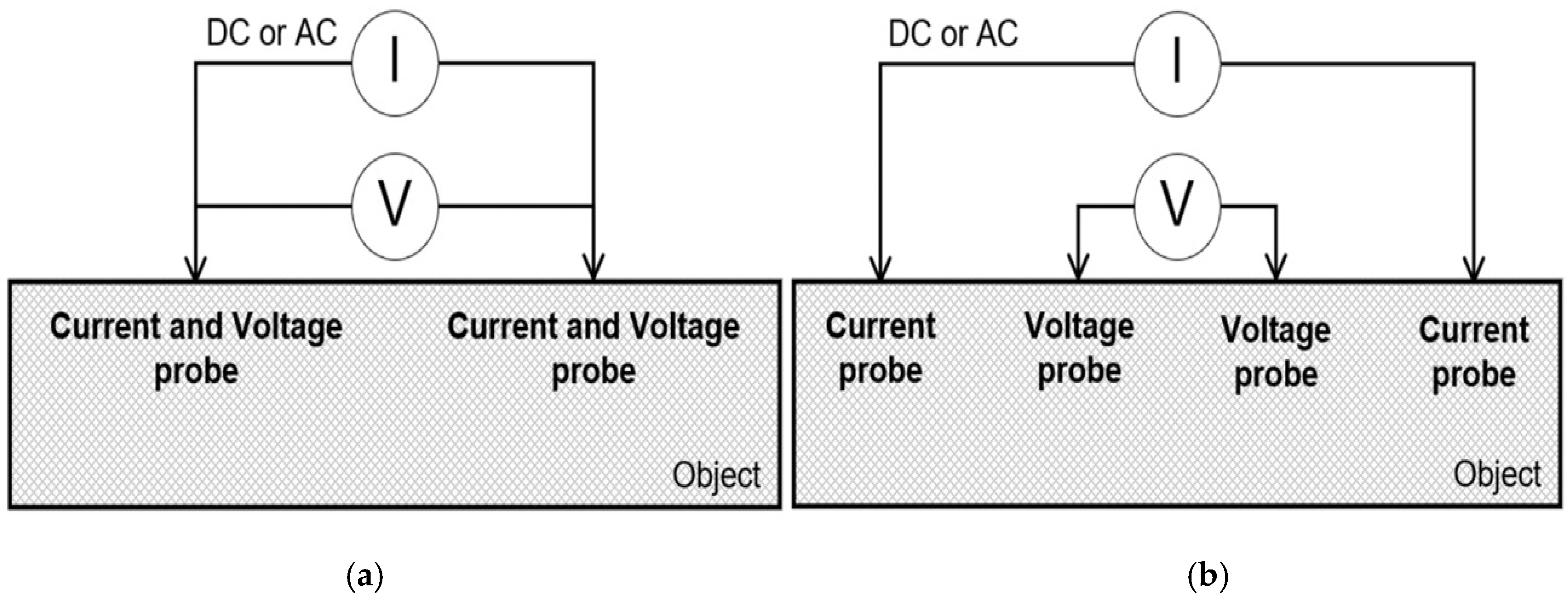
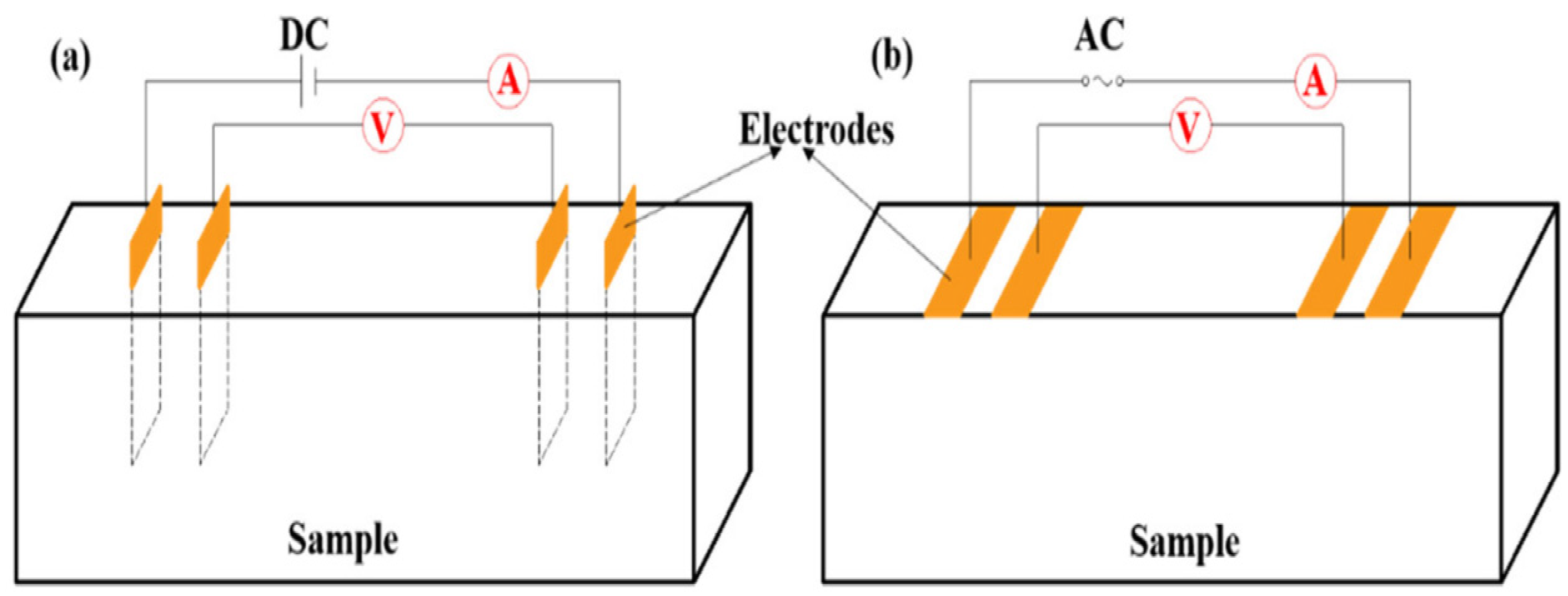
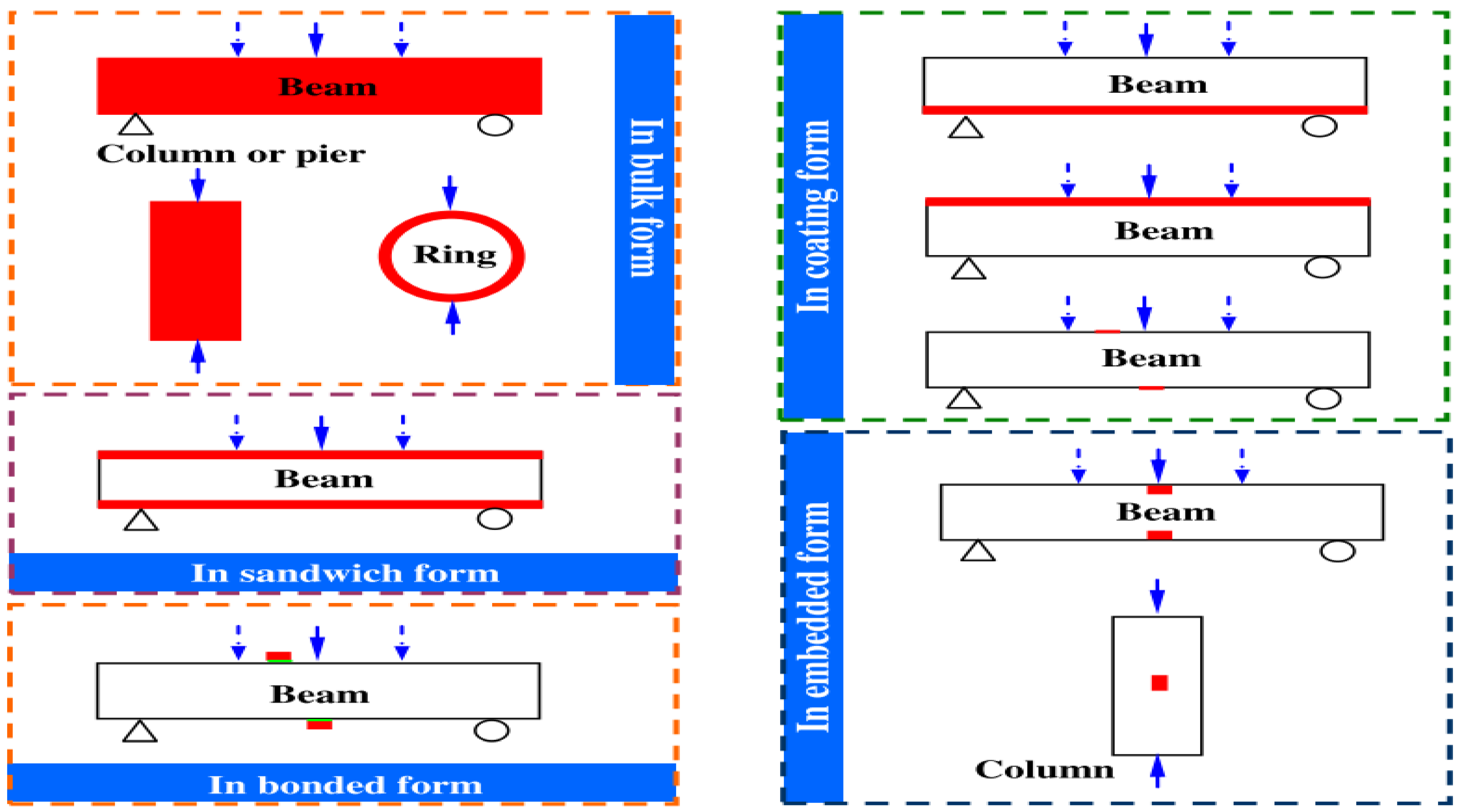
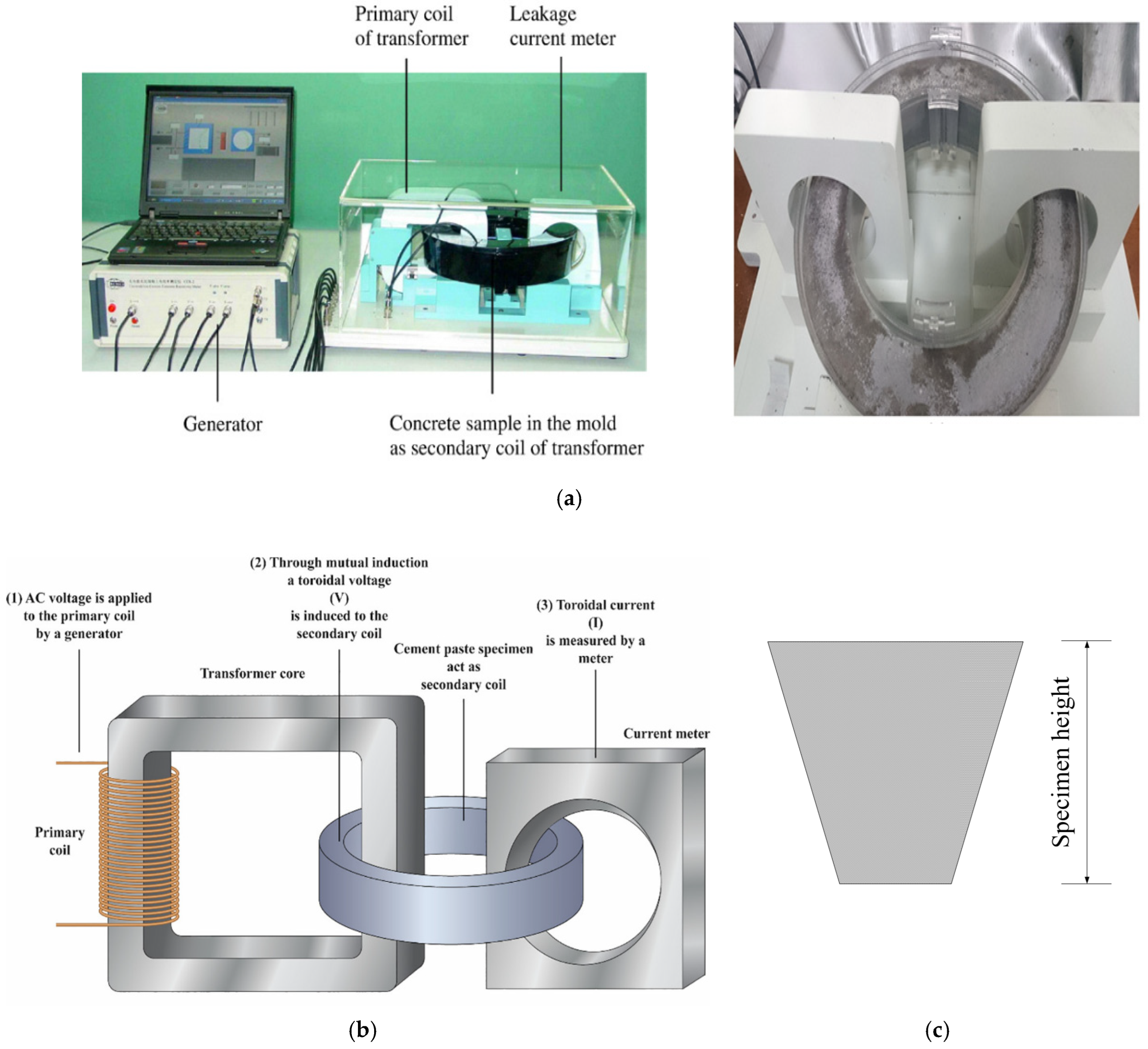


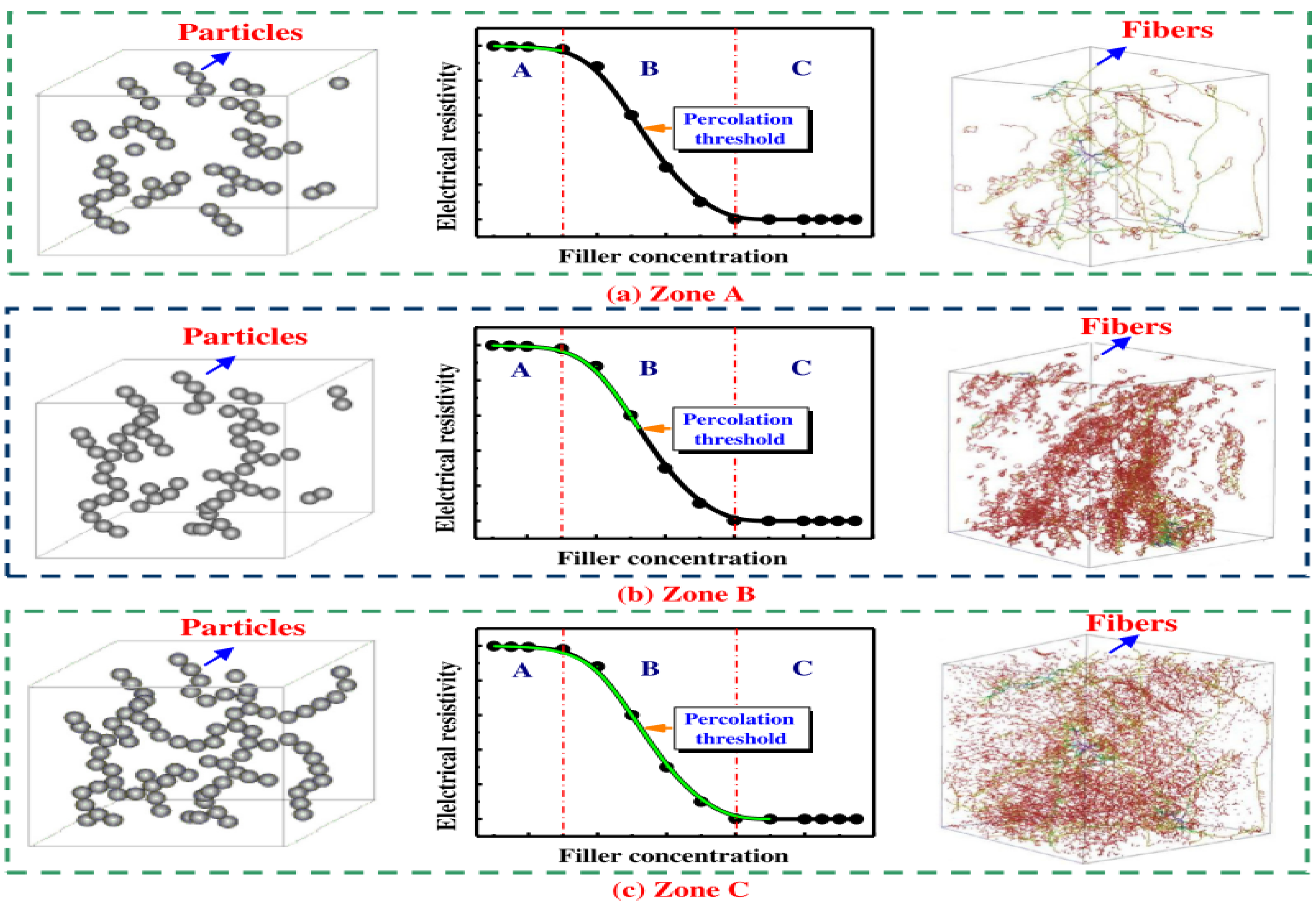



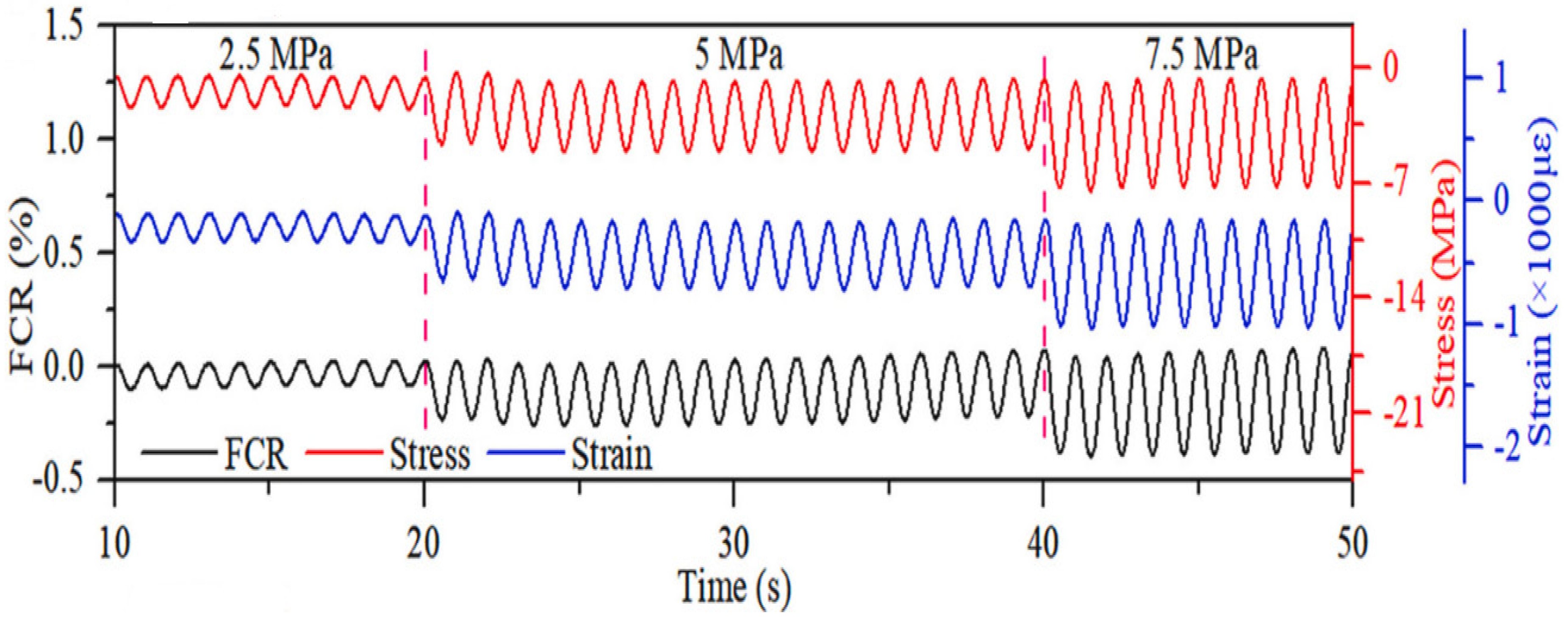
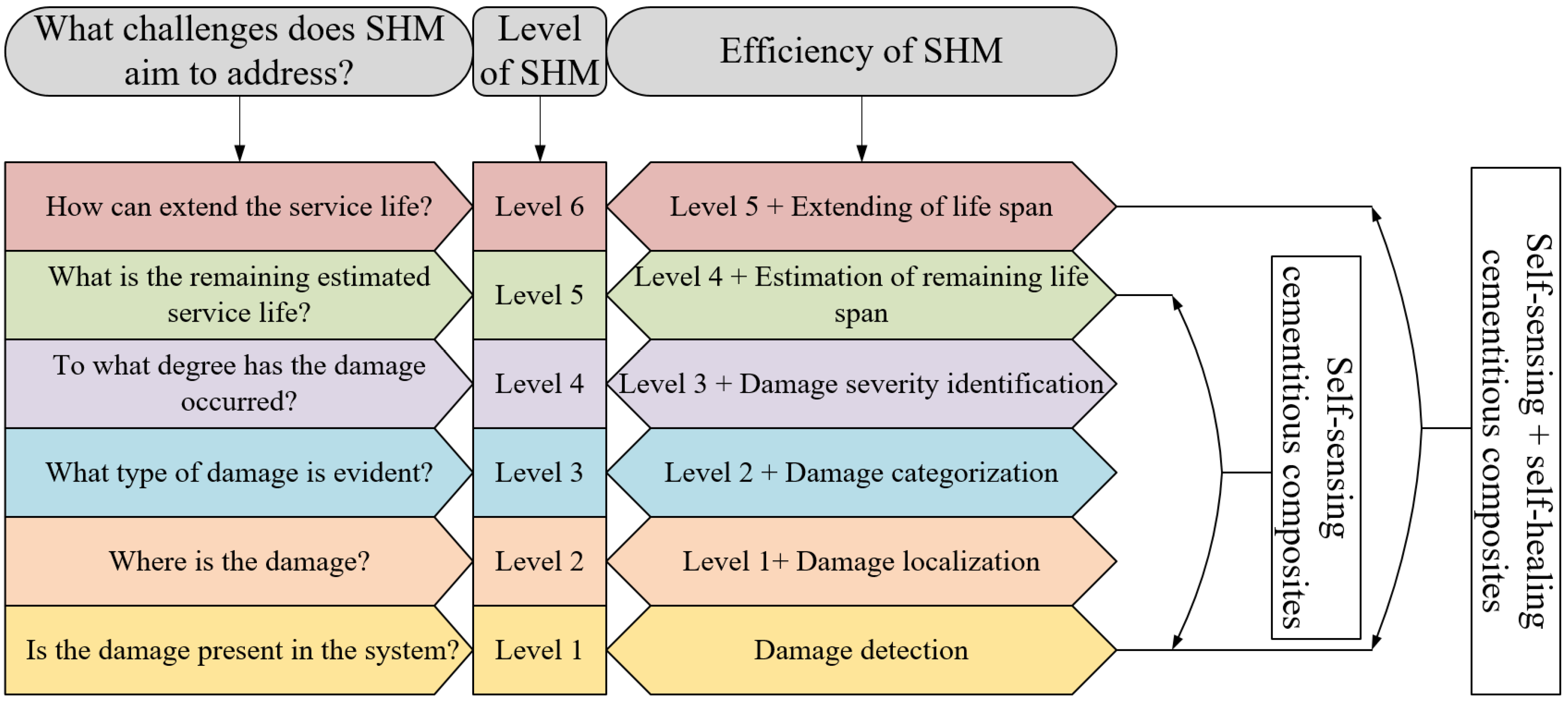
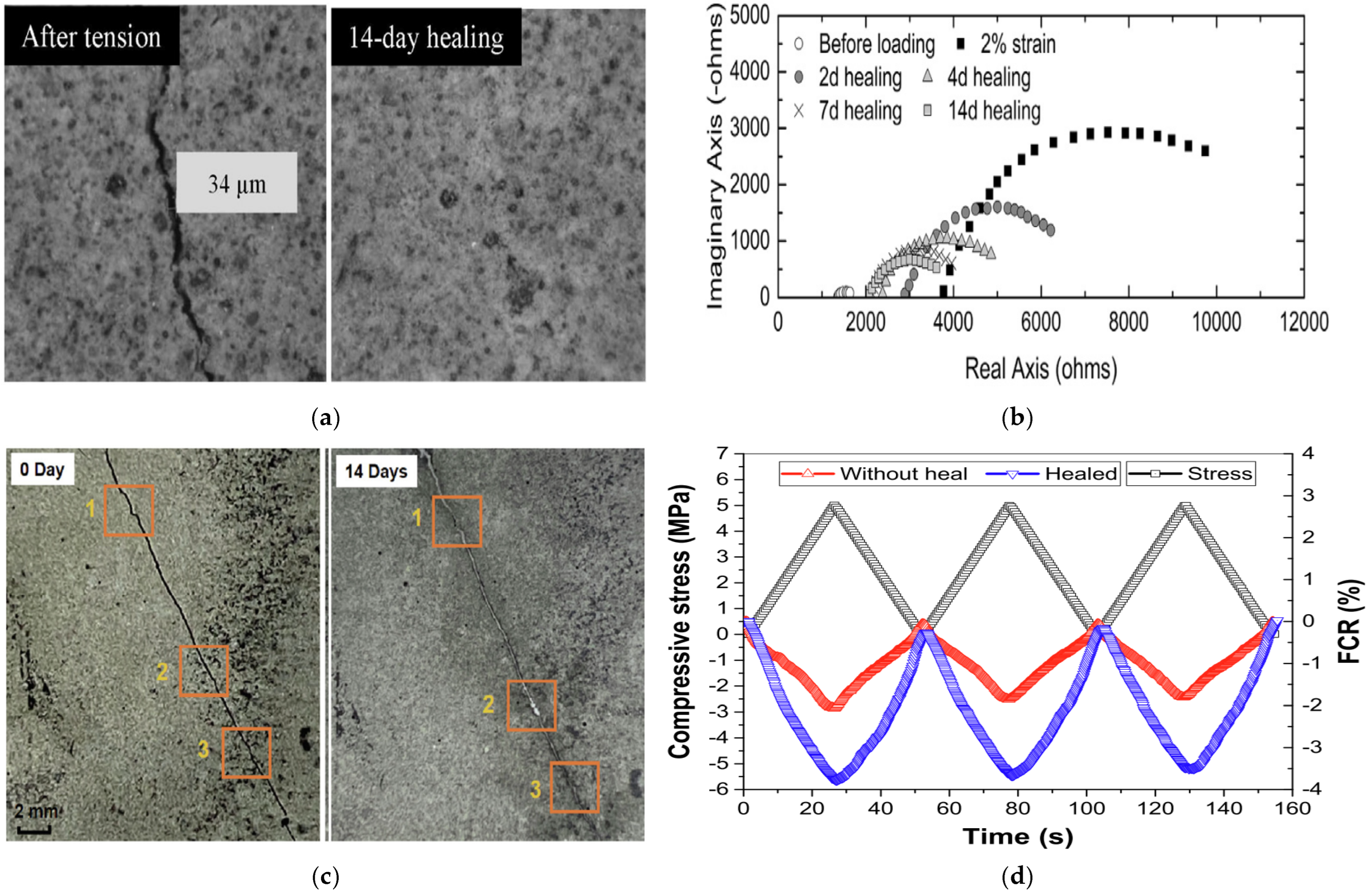
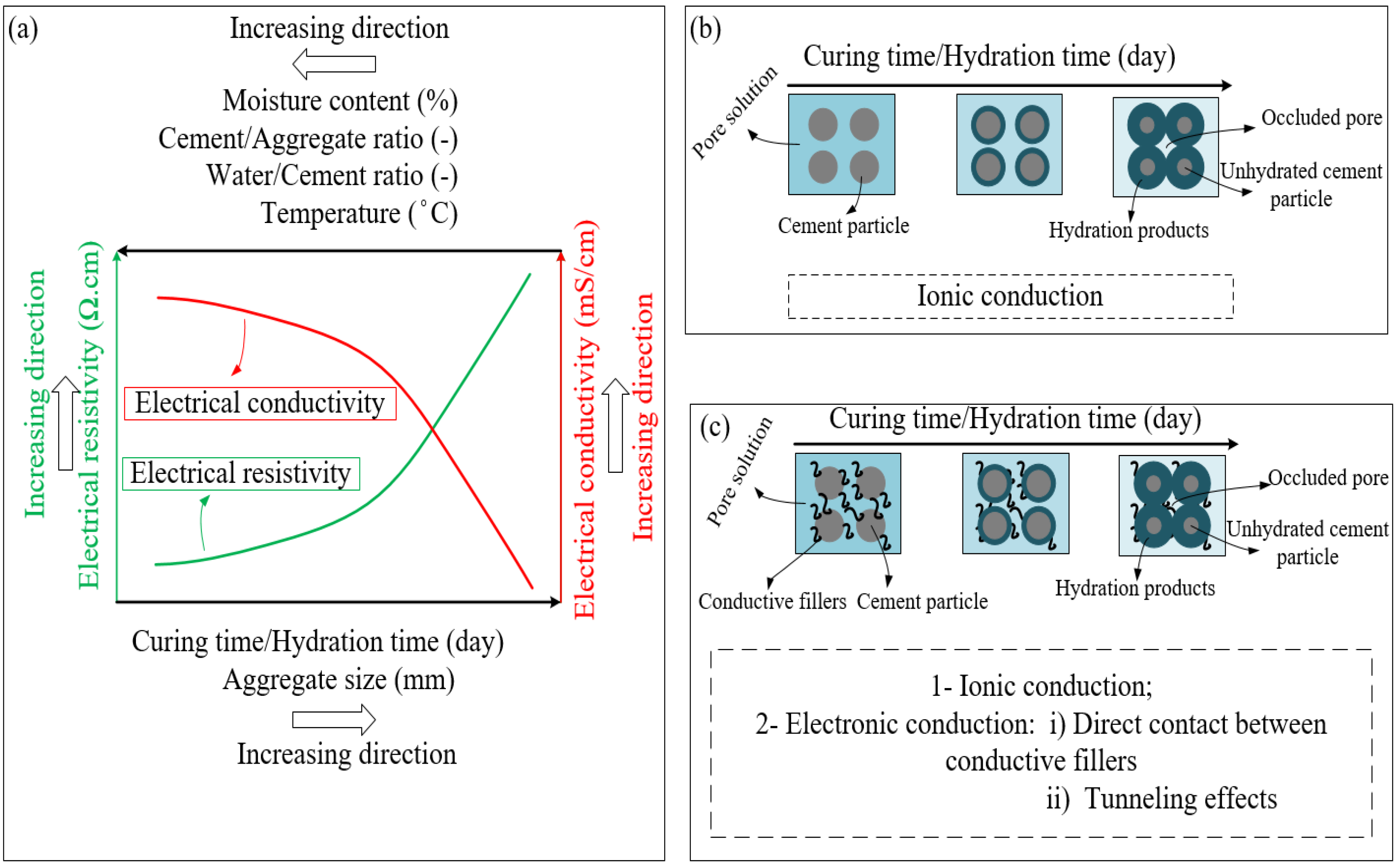
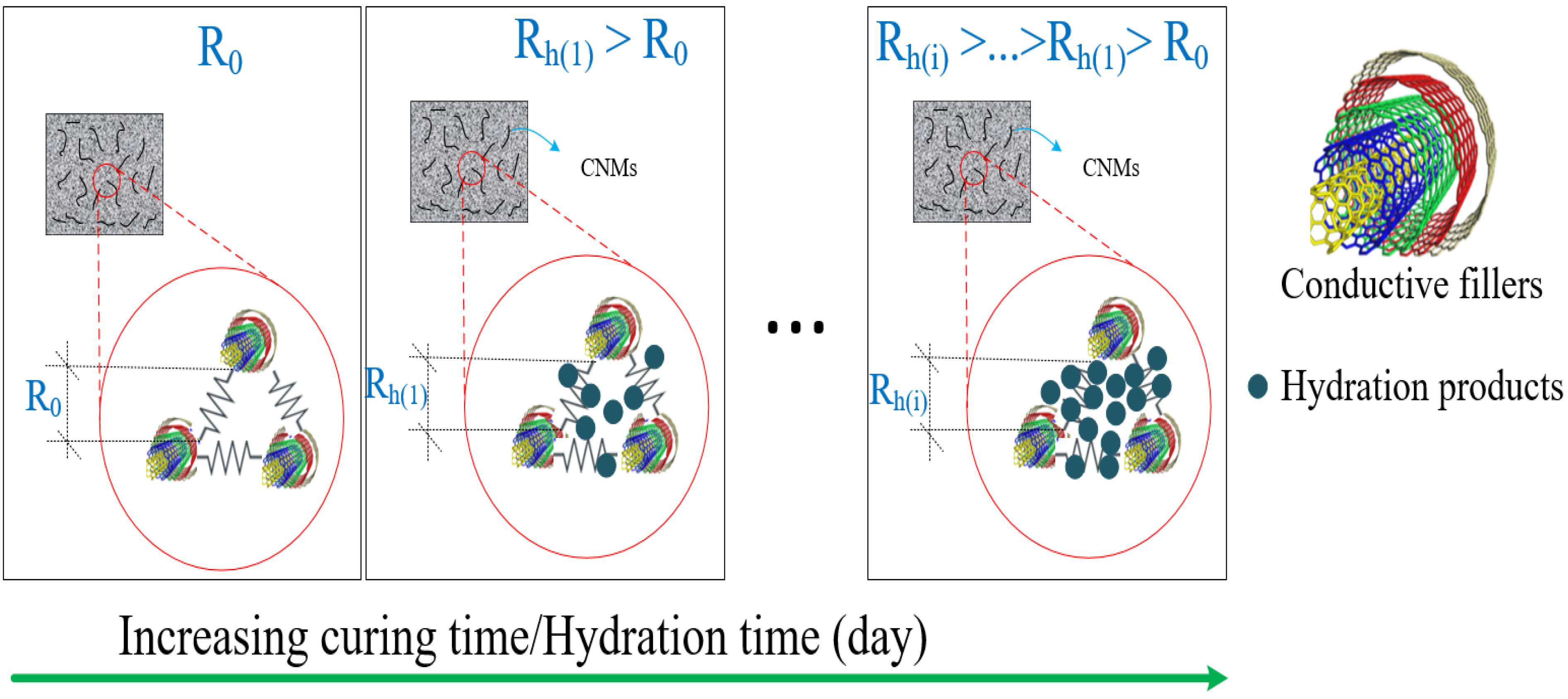


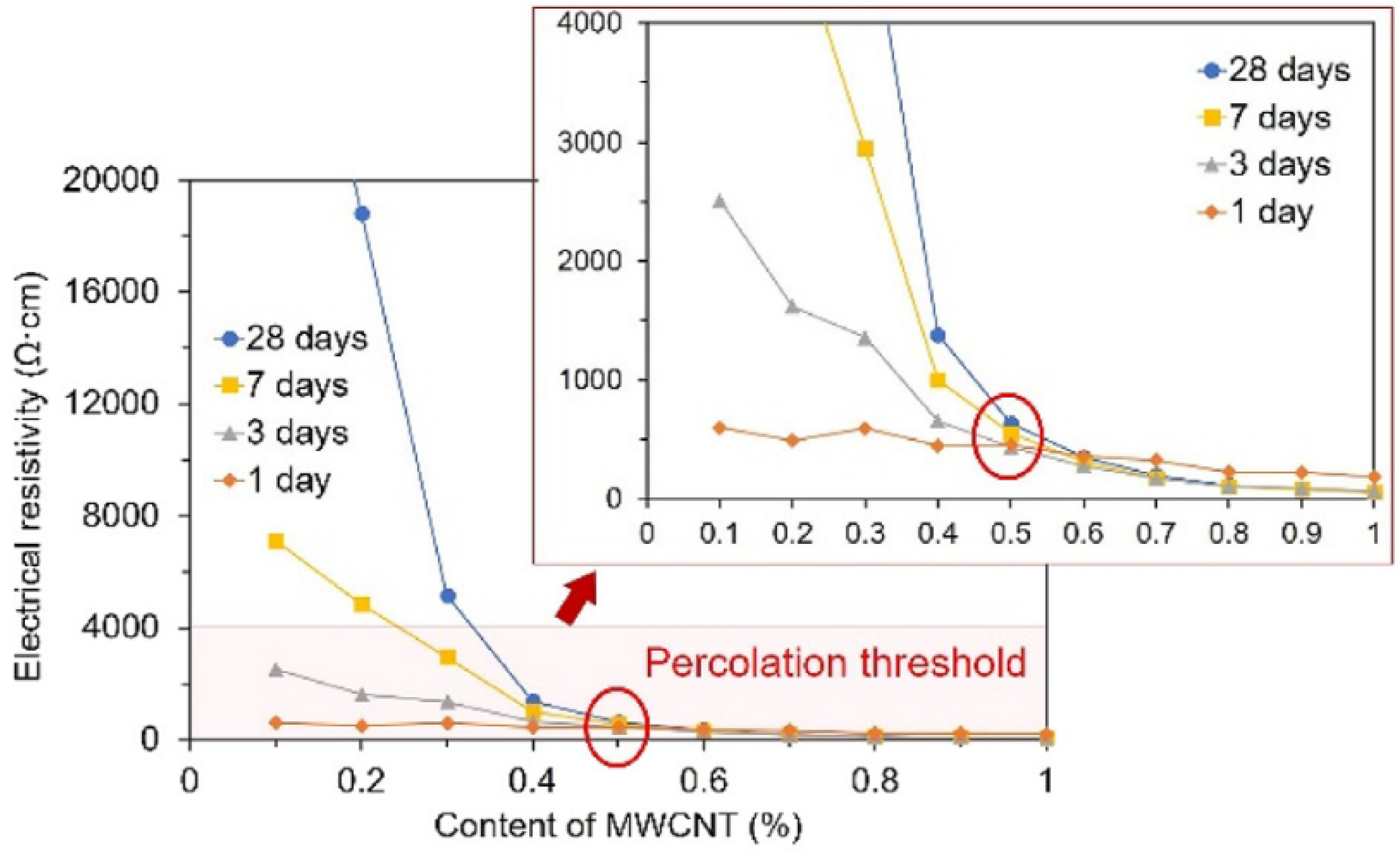
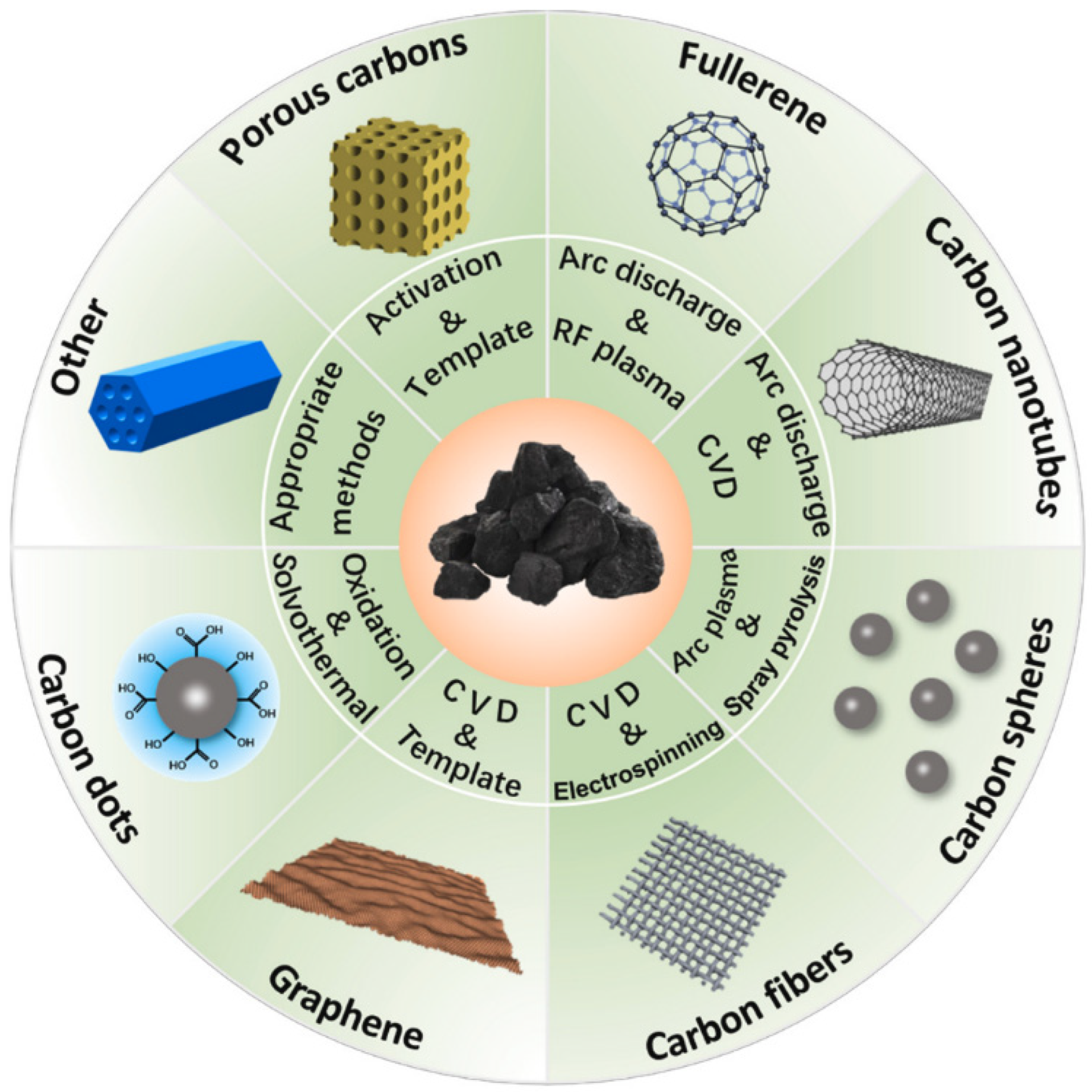
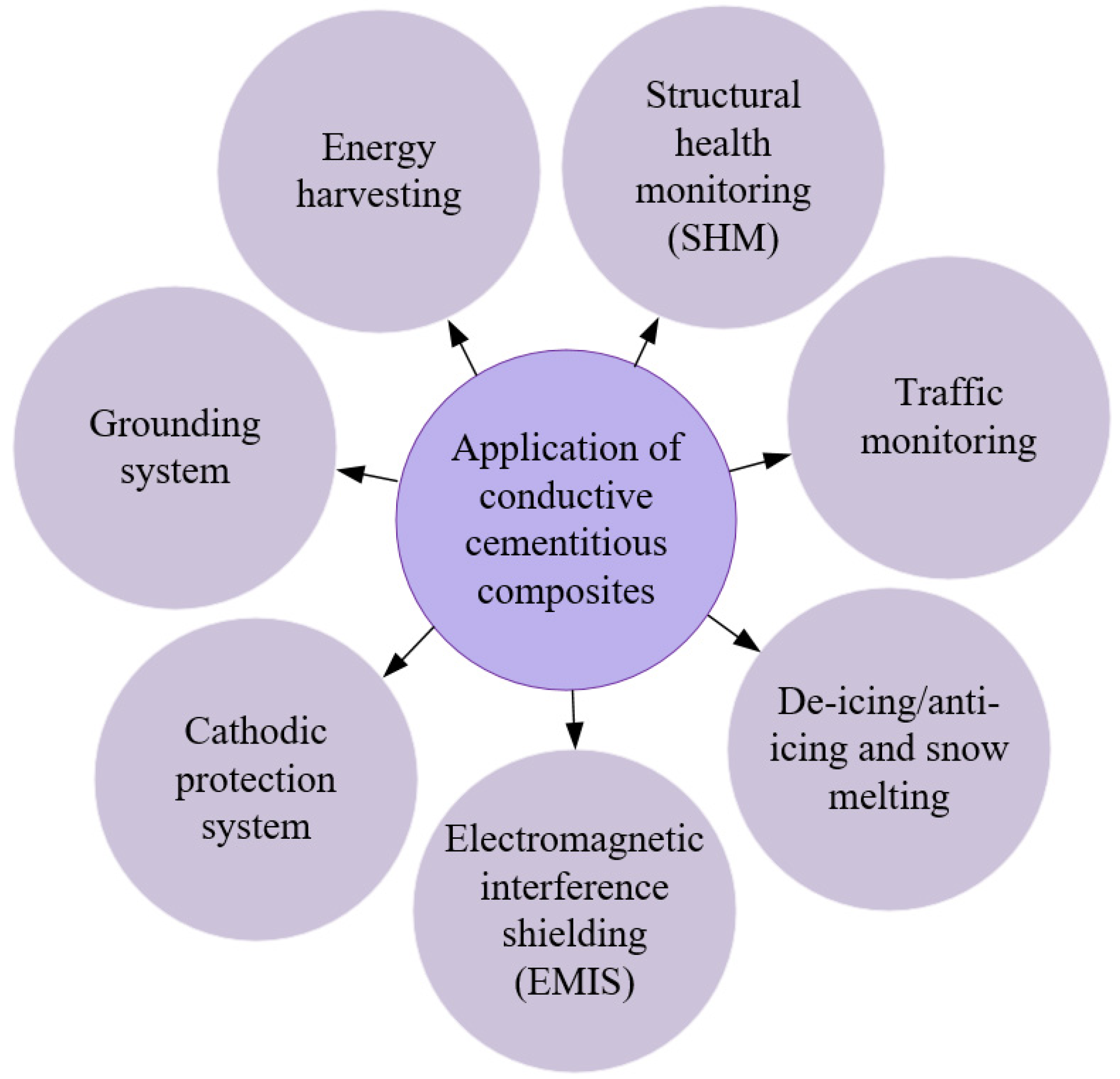

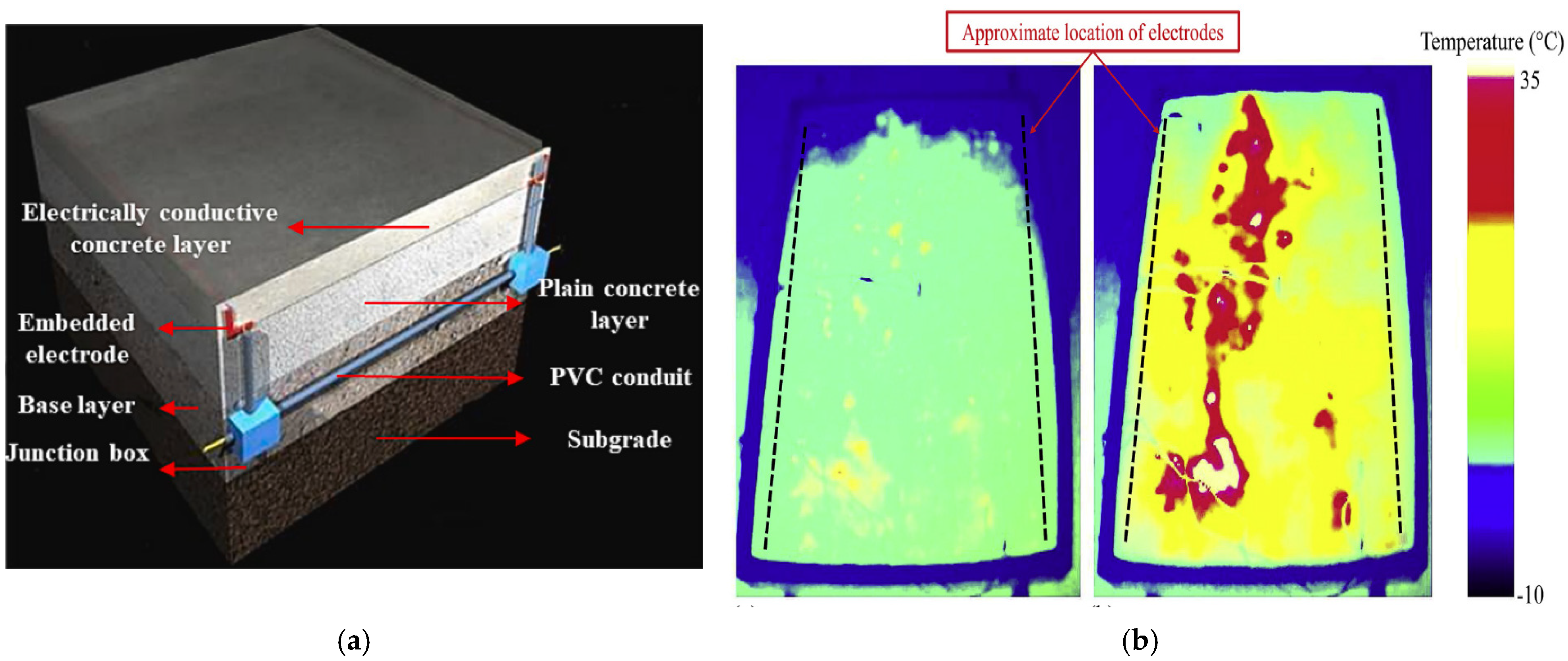
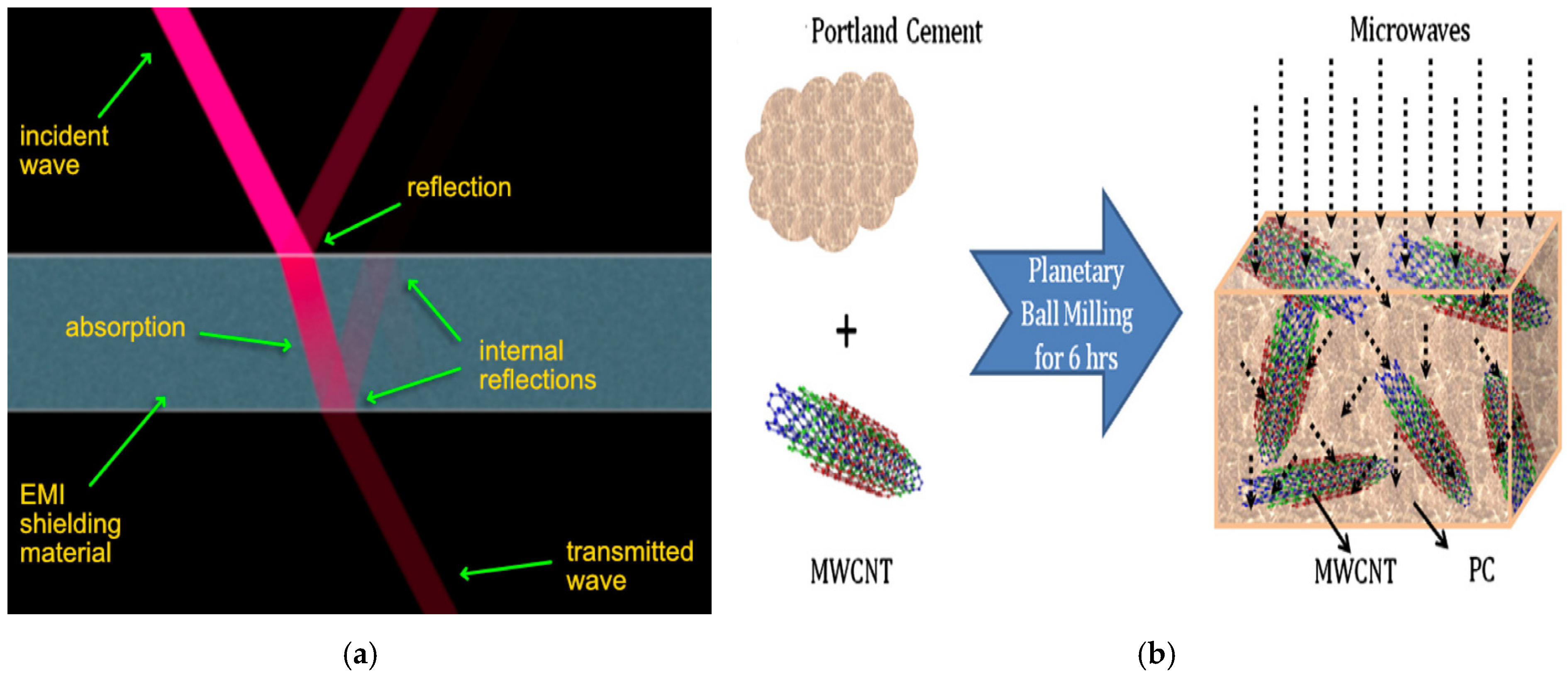


| Type of Measurement System | Calculation Formula | Schematic Diagram | References |
|---|---|---|---|
| Surface resistivity | ; s is the distance between electrodes Cylinder specimen: s is the distance between electroded is the diameter of cylinder specimen |  | [107,110,114,118] |
| Bulk resistivity | Mesh electrode/Plate electrode: ; s is the distance between electrodes and A is the cross-sectional area perpendicular to the direction of current. | 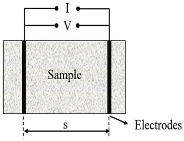 | [118] |
| Rod electrodes with equal distances: | 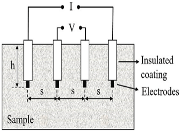 | ||
| Non-contact measurement system: |  | [96,118] |
| Reference | Material Type | Activator | Precursor | Conductive Filler |
|---|---|---|---|---|
| [204] | Paste | Na2SiO3 + NaOH | Fly ash class C | Carbon fiber (0.5 wt.%) |
| [205] | Paste | K2SiO3 + KOH | GGBFS | SWCNTs (0.2 wt.%) |
| [206] | Mortar | Na2SiO3 | GGBFS | Graphite powder (30 wt.%) |
| [207] | Mortar | Na2SiO3 + NaOH | Fly ash class C + GGBFS | Carbon fiber (0.5% volume) |
| [208] | Mortar | Na2SiO3 + NaOH | Fly ash Class F | MWCNTs (1 wt.%) |
| [209] | Paste | Na2SiO3 + NaOH | Fly ash Class F | Graphene oxide (0.35 wt.%) |
Disclaimer/Publisher’s Note: The statements, opinions and data contained in all publications are solely those of the individual author(s) and contributor(s) and not of MDPI and/or the editor(s). MDPI and/or the editor(s) disclaim responsibility for any injury to people or property resulting from any ideas, methods, instructions or products referred to in the content. |
© 2025 by the authors. Licensee MDPI, Basel, Switzerland. This article is an open access article distributed under the terms and conditions of the Creative Commons Attribution (CC BY) license (https://creativecommons.org/licenses/by/4.0/).
Share and Cite
Roshan, M.J.; Gomes Correia, A. Multifunctional Cementitious Composites from Fabrication to Their Application in Pavement: A Comprehensive Review. Appl. Sci. 2025, 15, 3451. https://doi.org/10.3390/app15073451
Roshan MJ, Gomes Correia A. Multifunctional Cementitious Composites from Fabrication to Their Application in Pavement: A Comprehensive Review. Applied Sciences. 2025; 15(7):3451. https://doi.org/10.3390/app15073451
Chicago/Turabian StyleRoshan, Mohammad Jawed, and António Gomes Correia. 2025. "Multifunctional Cementitious Composites from Fabrication to Their Application in Pavement: A Comprehensive Review" Applied Sciences 15, no. 7: 3451. https://doi.org/10.3390/app15073451
APA StyleRoshan, M. J., & Gomes Correia, A. (2025). Multifunctional Cementitious Composites from Fabrication to Their Application in Pavement: A Comprehensive Review. Applied Sciences, 15(7), 3451. https://doi.org/10.3390/app15073451






